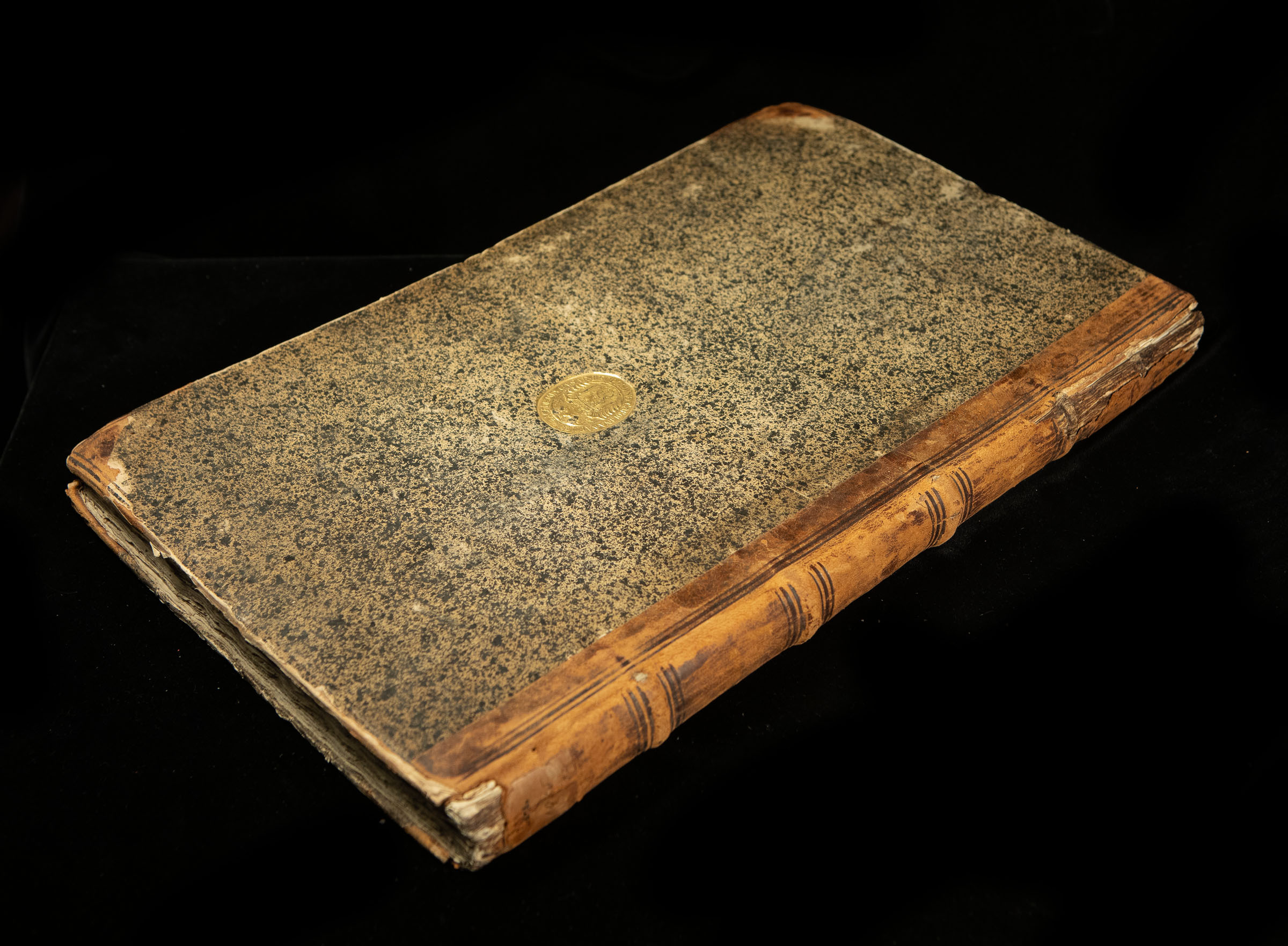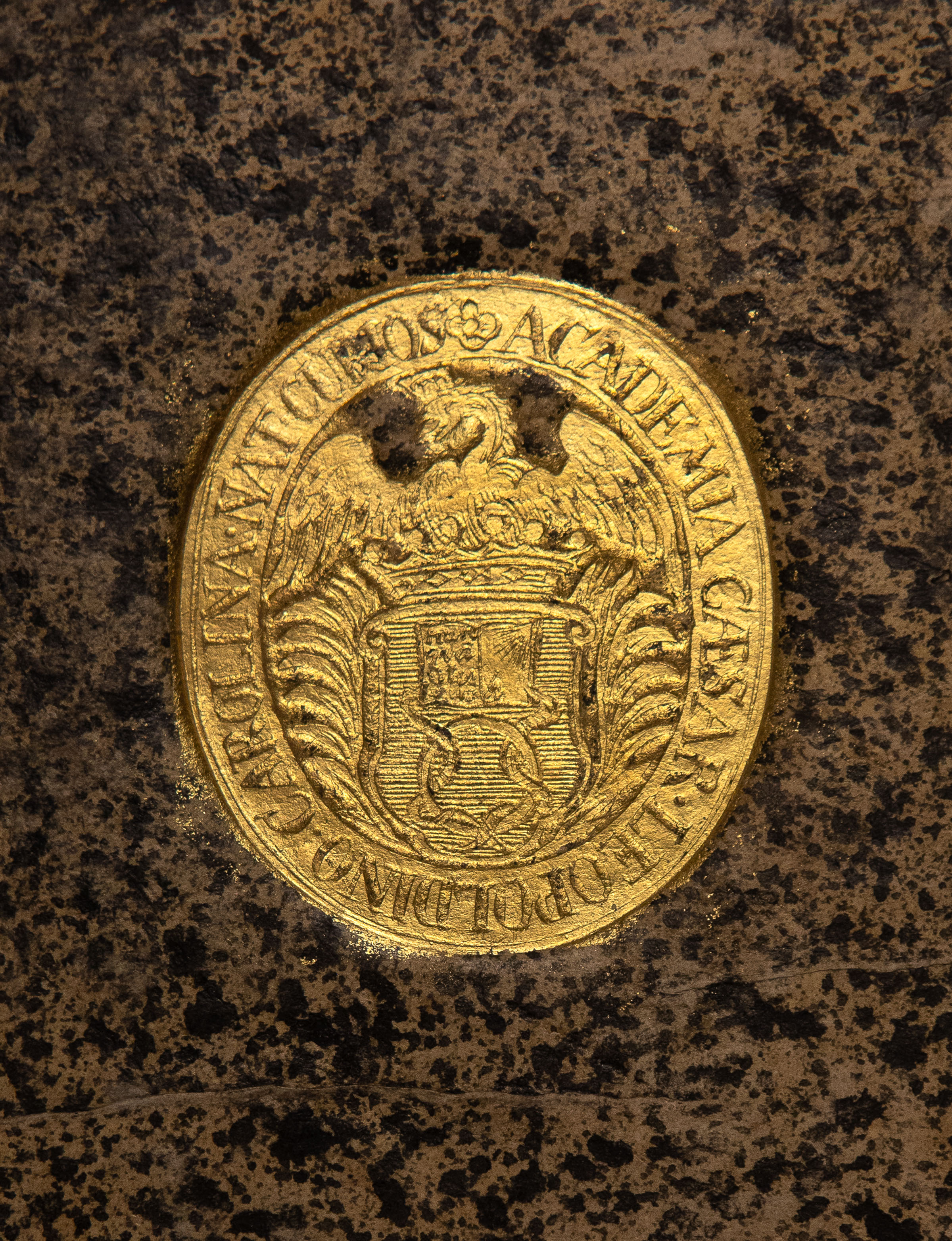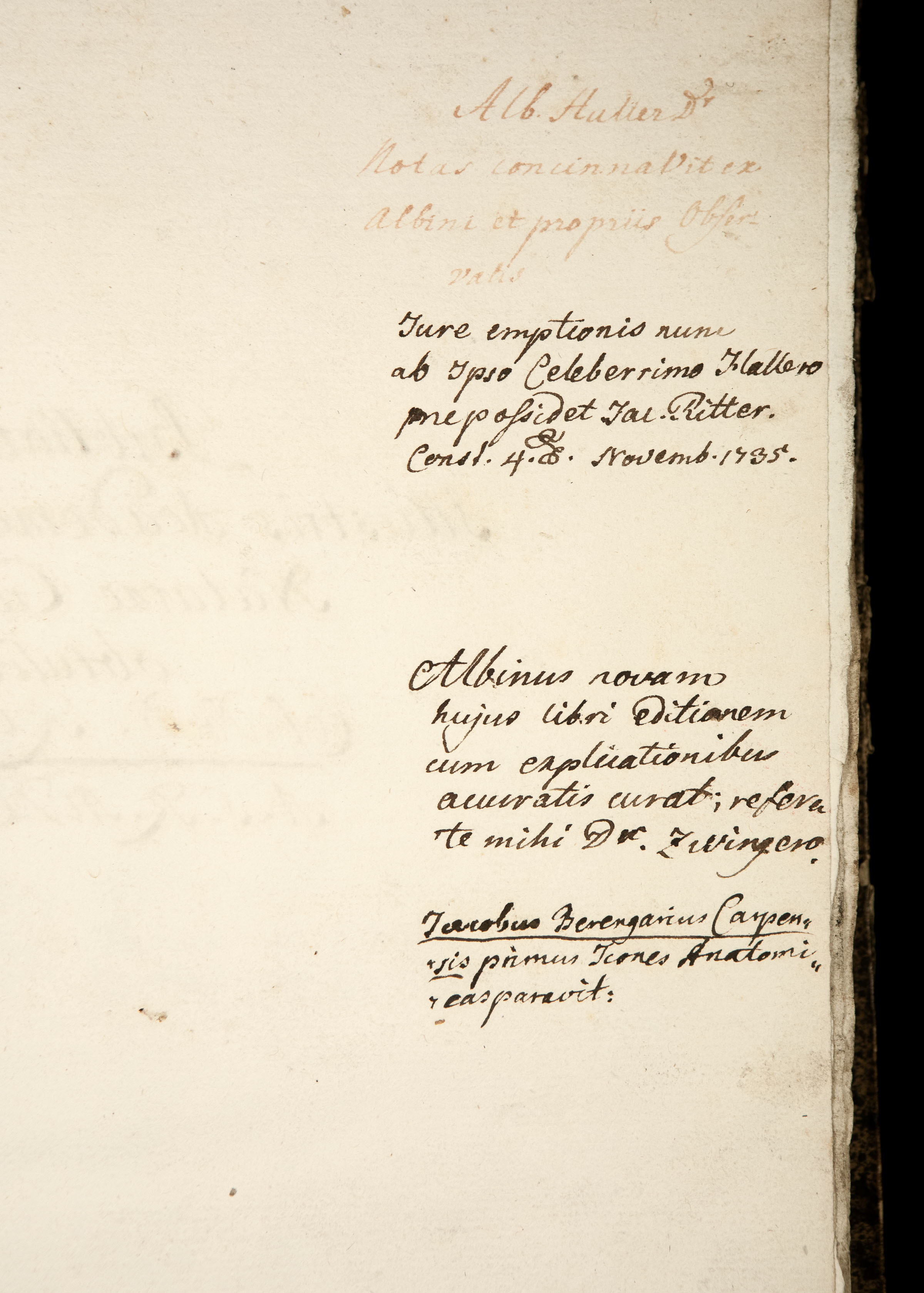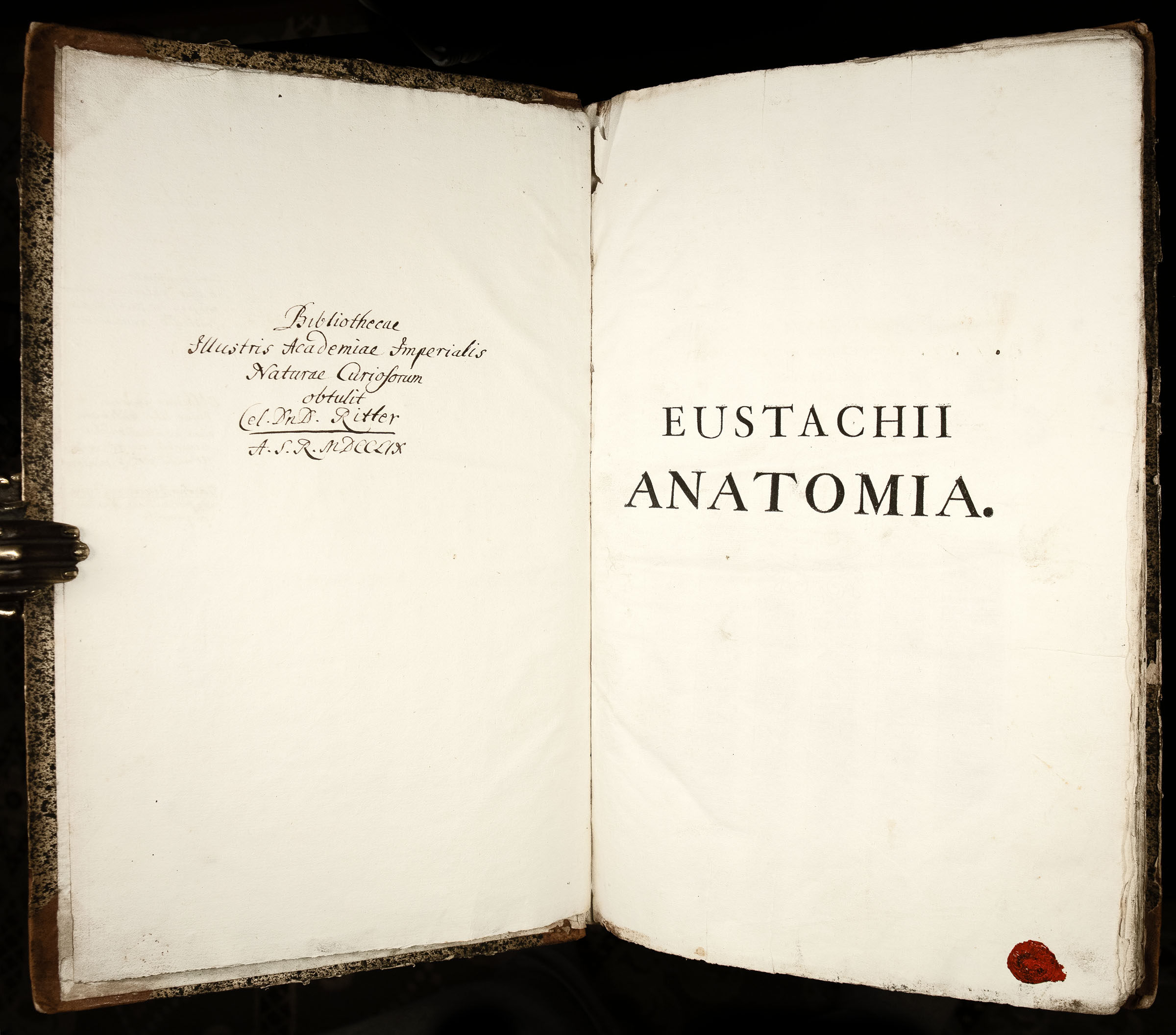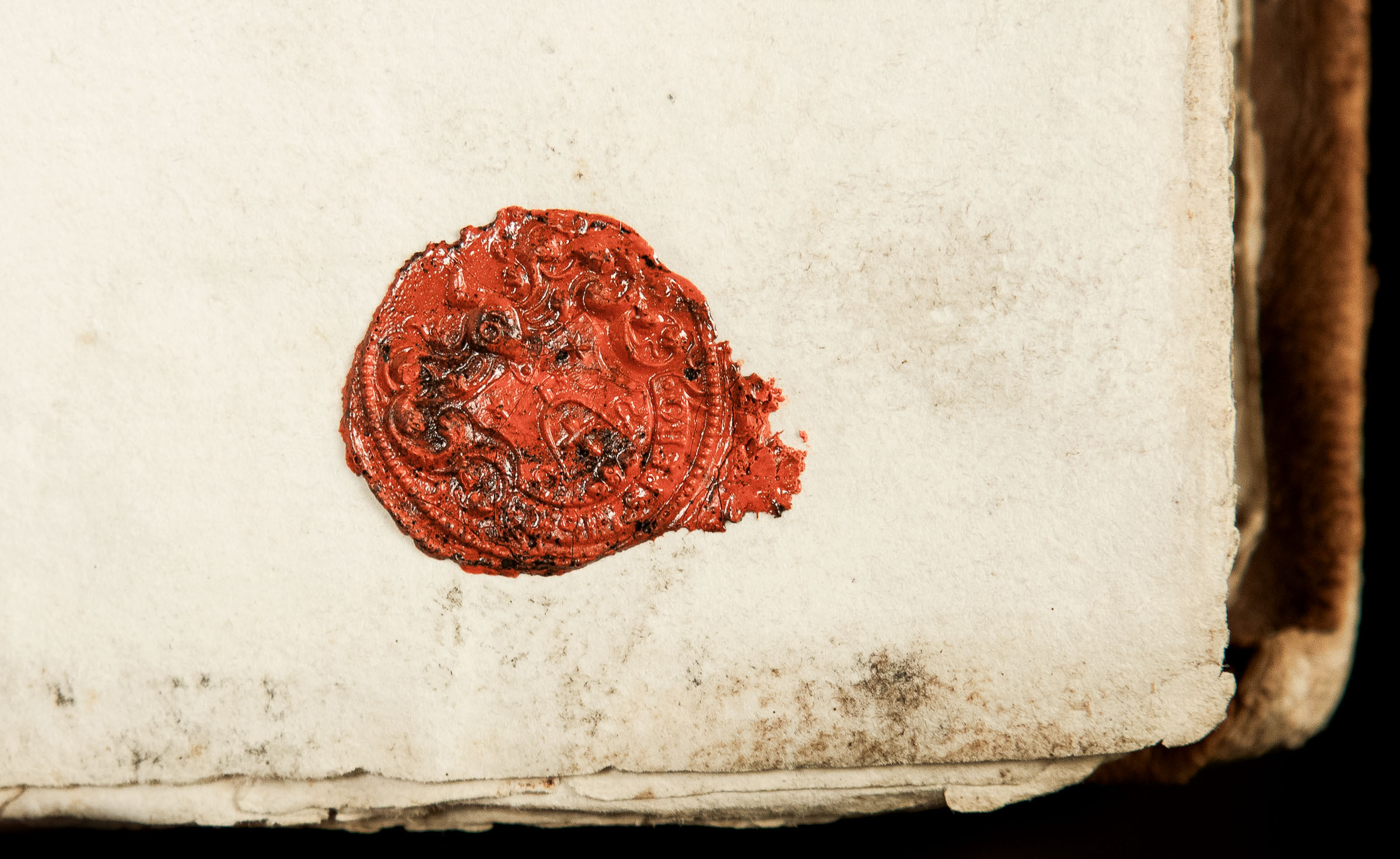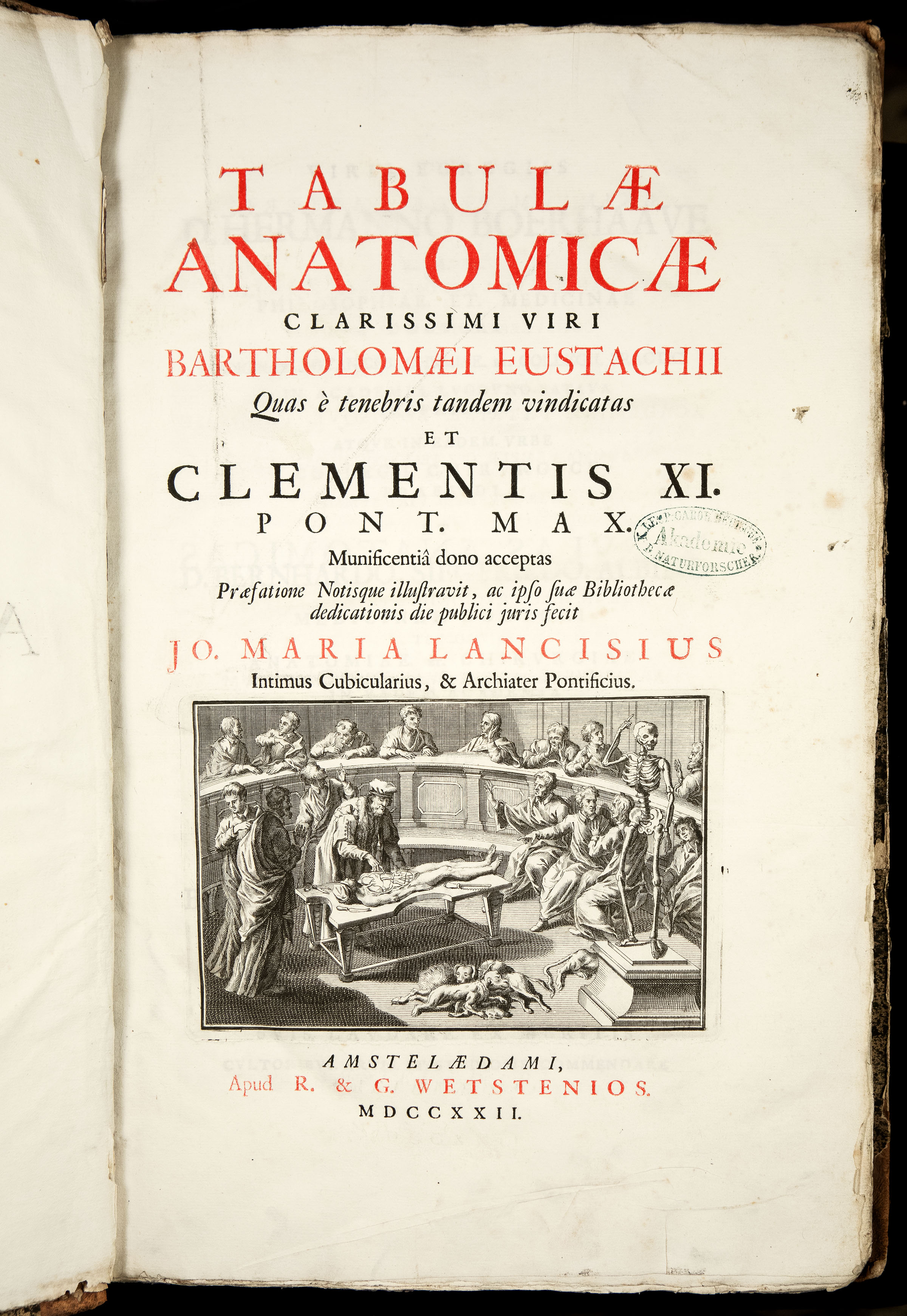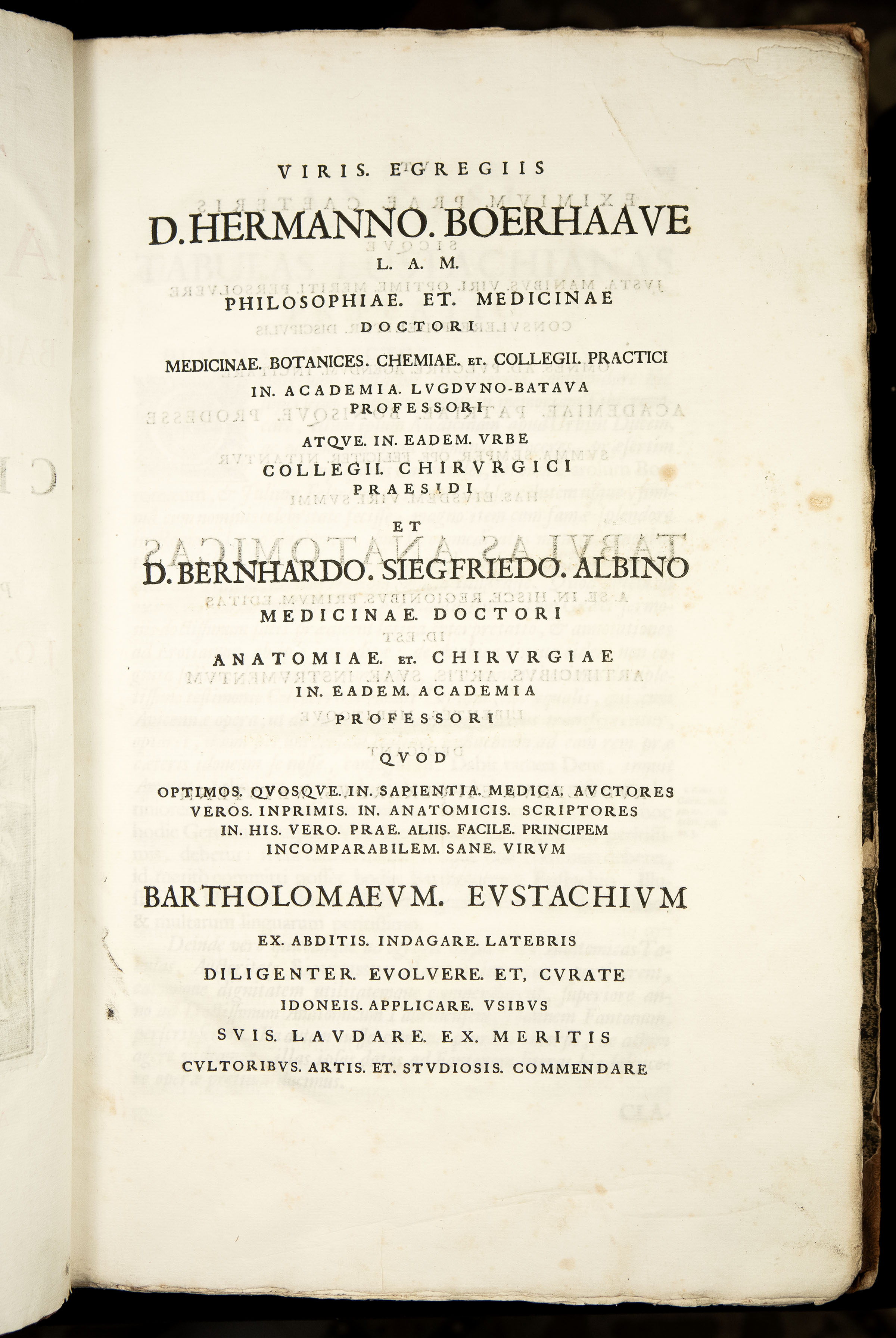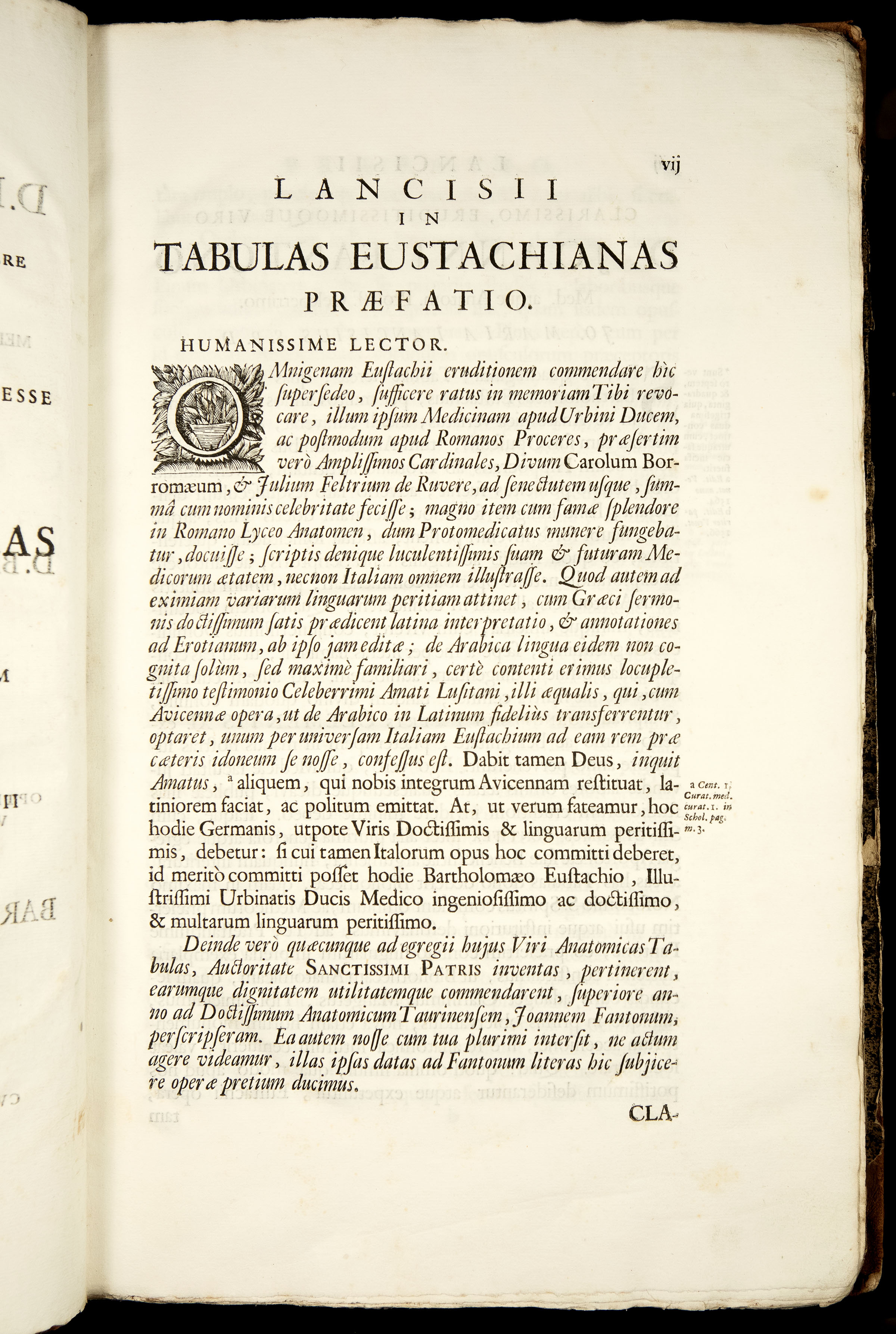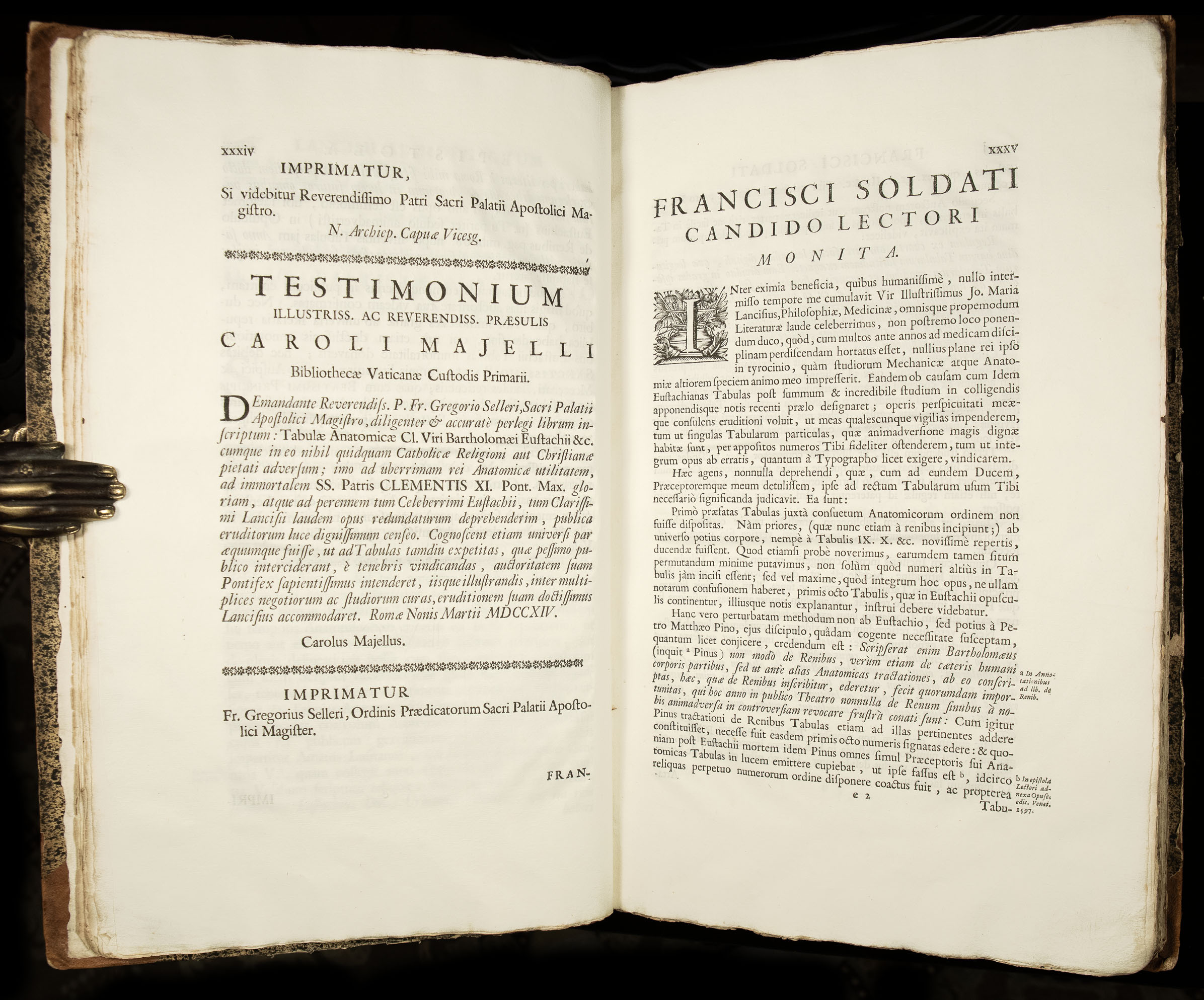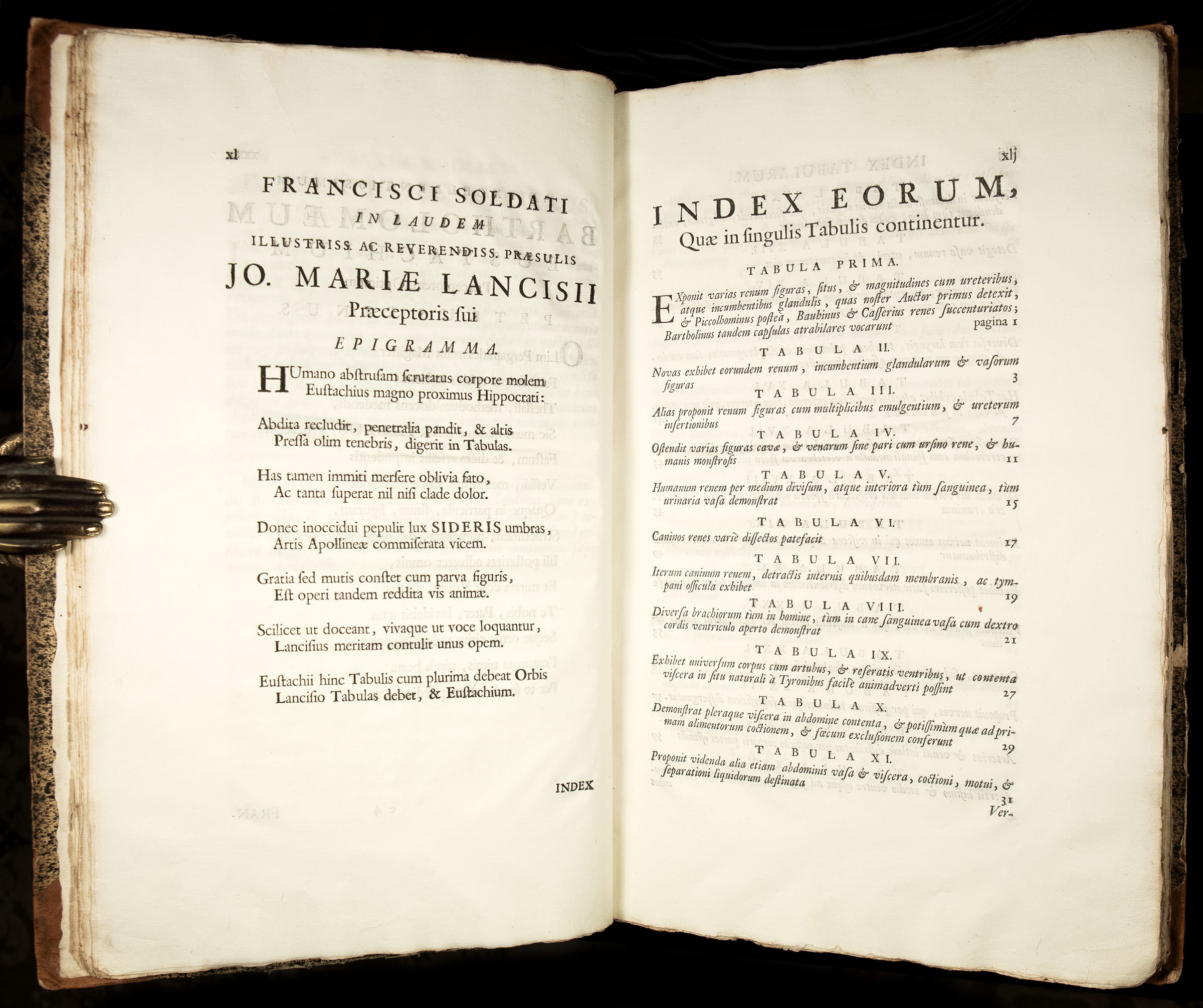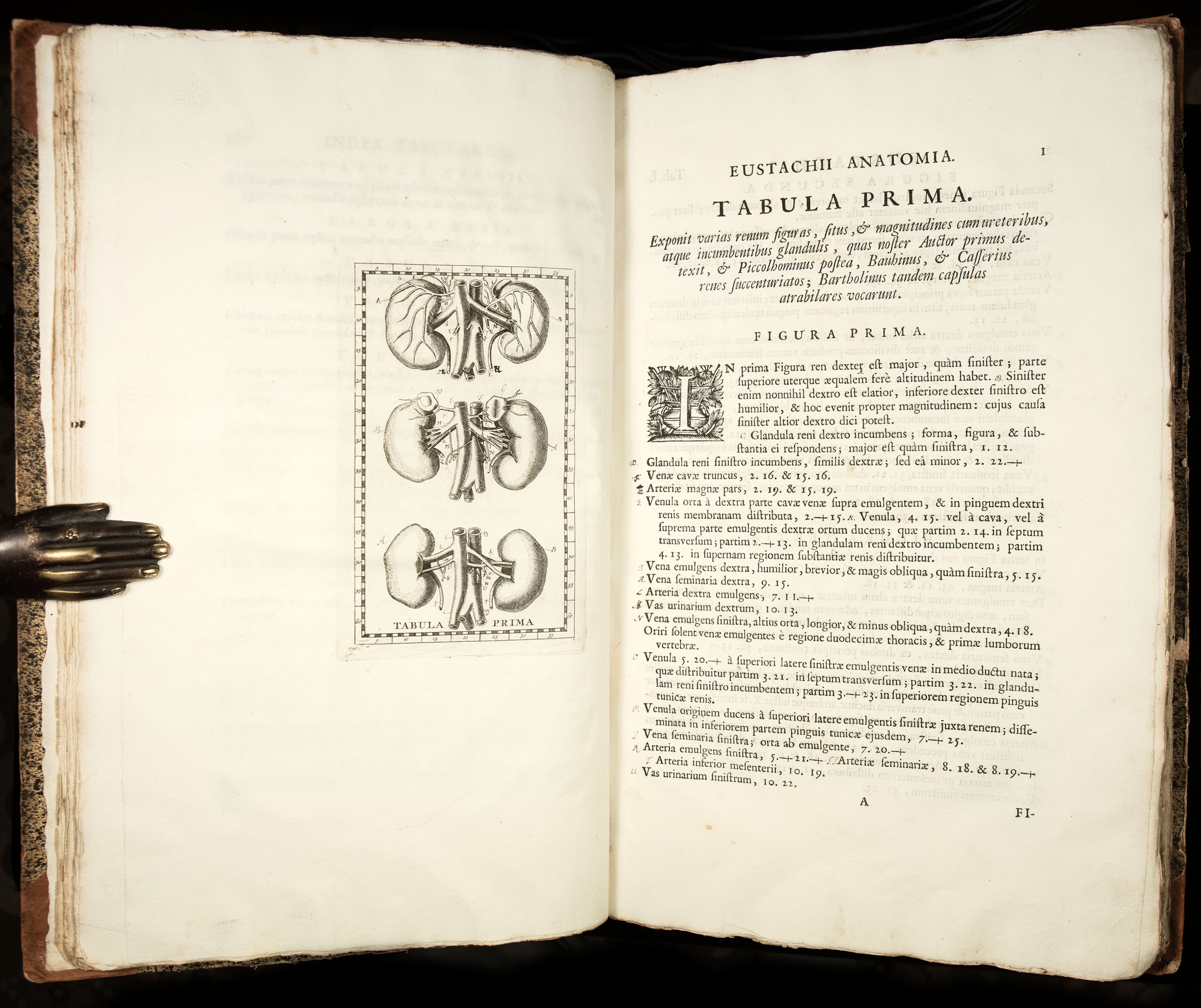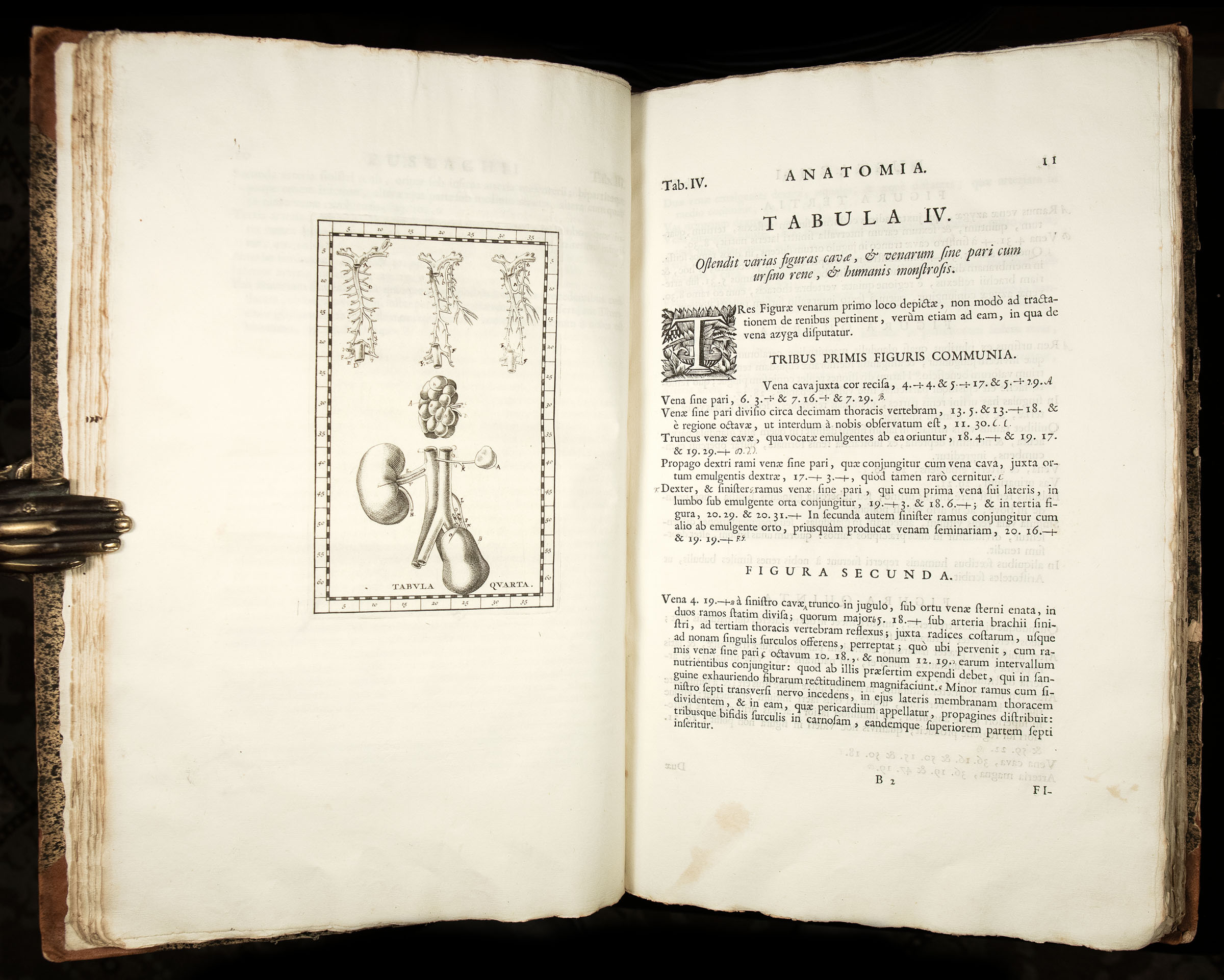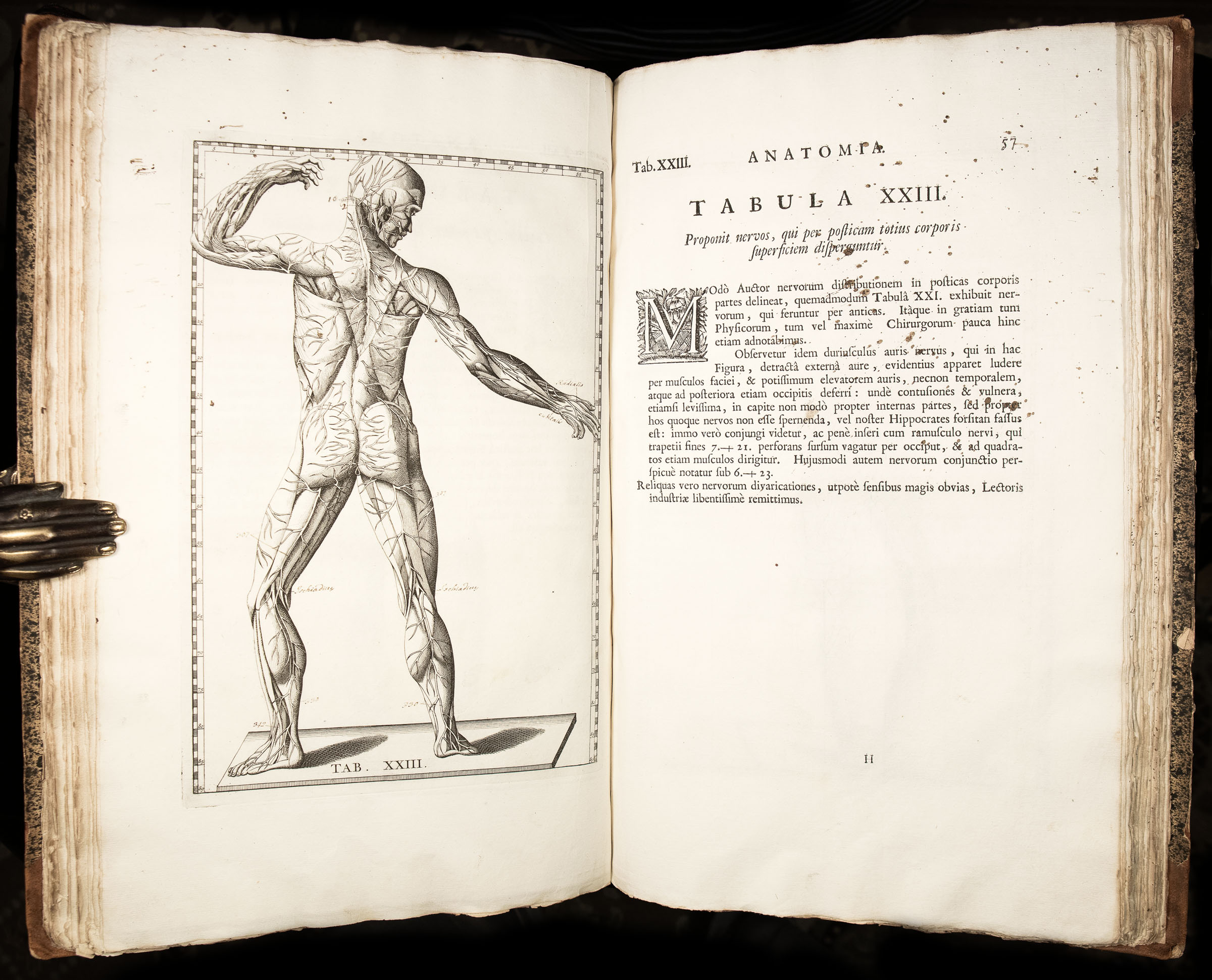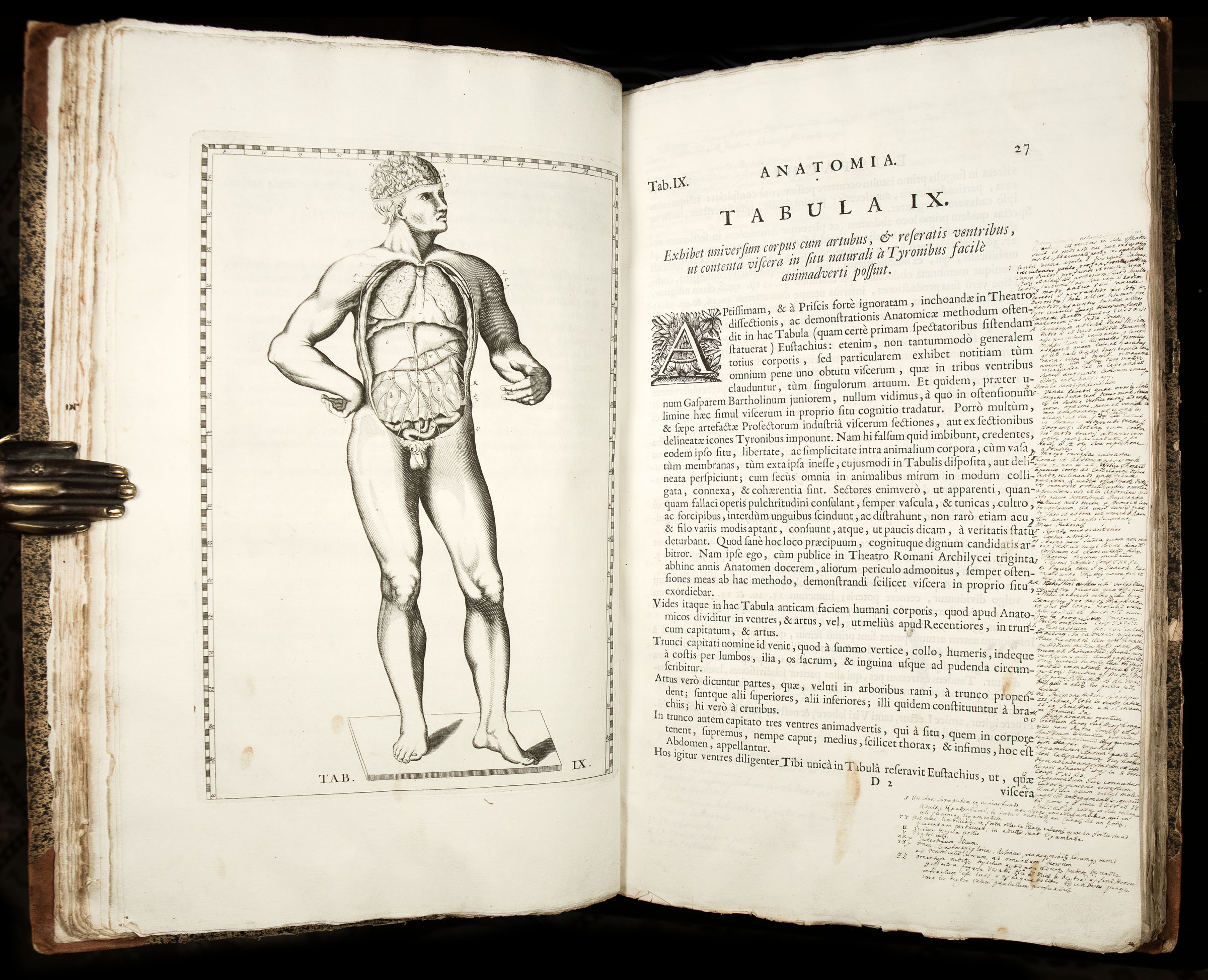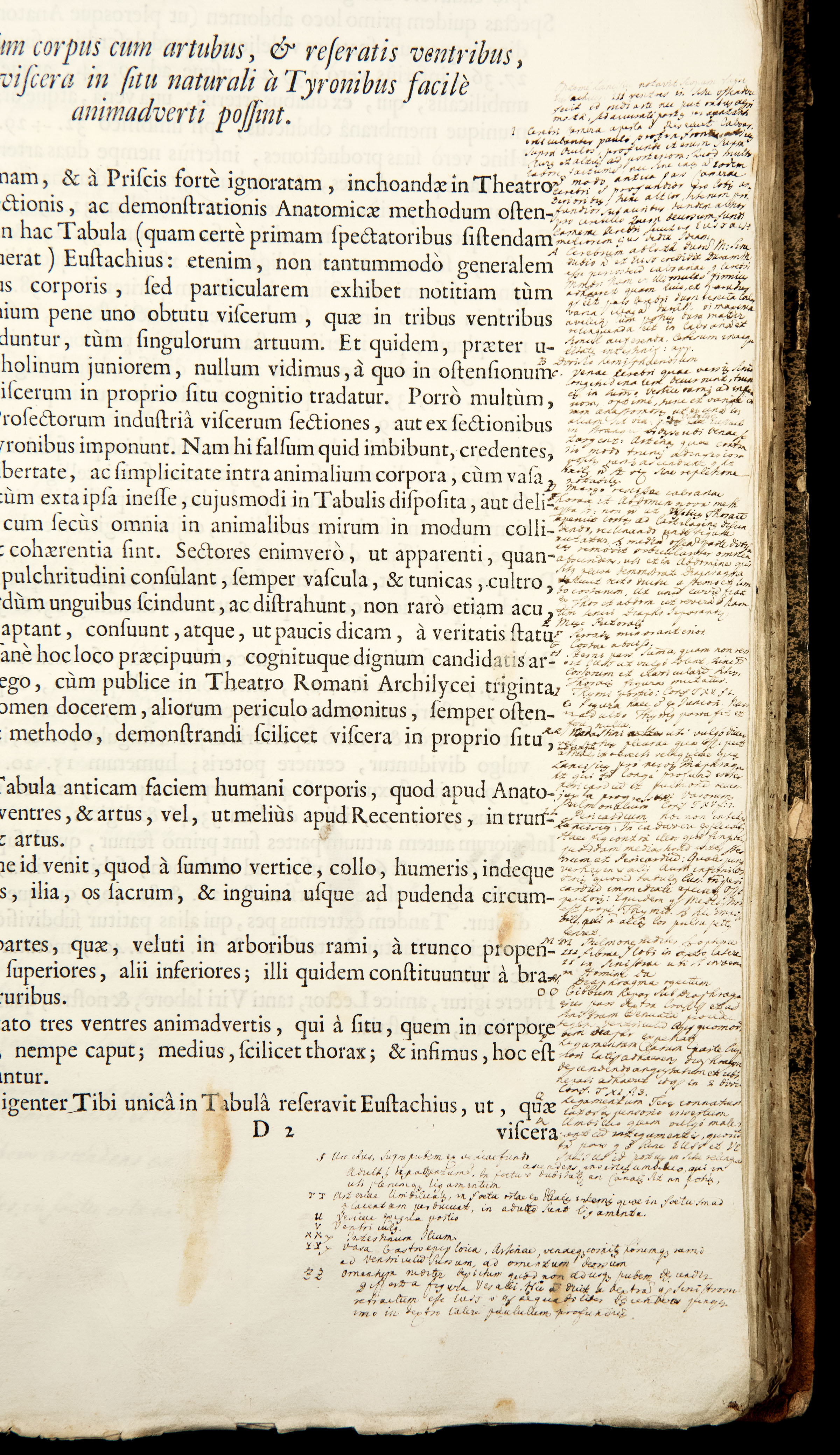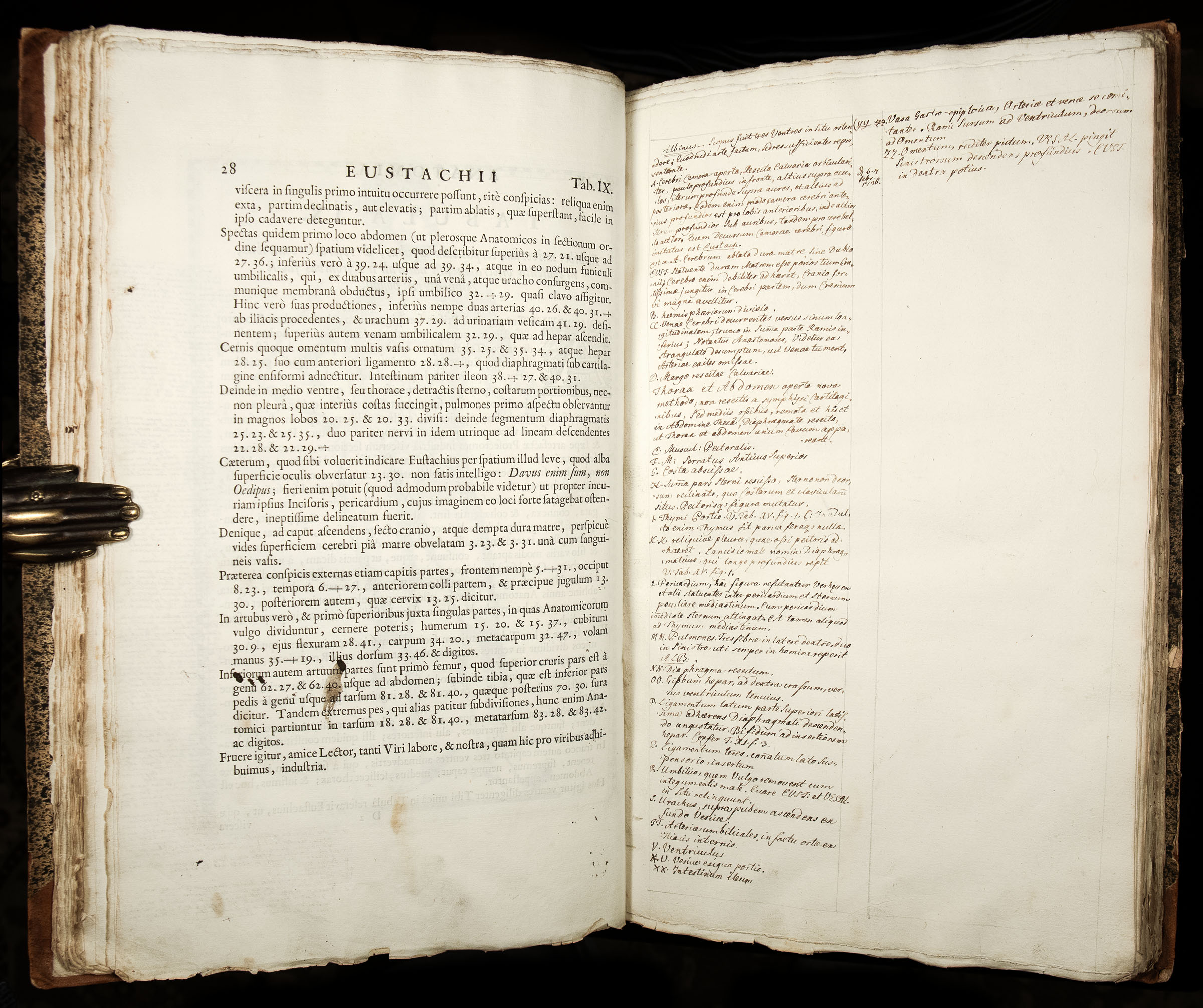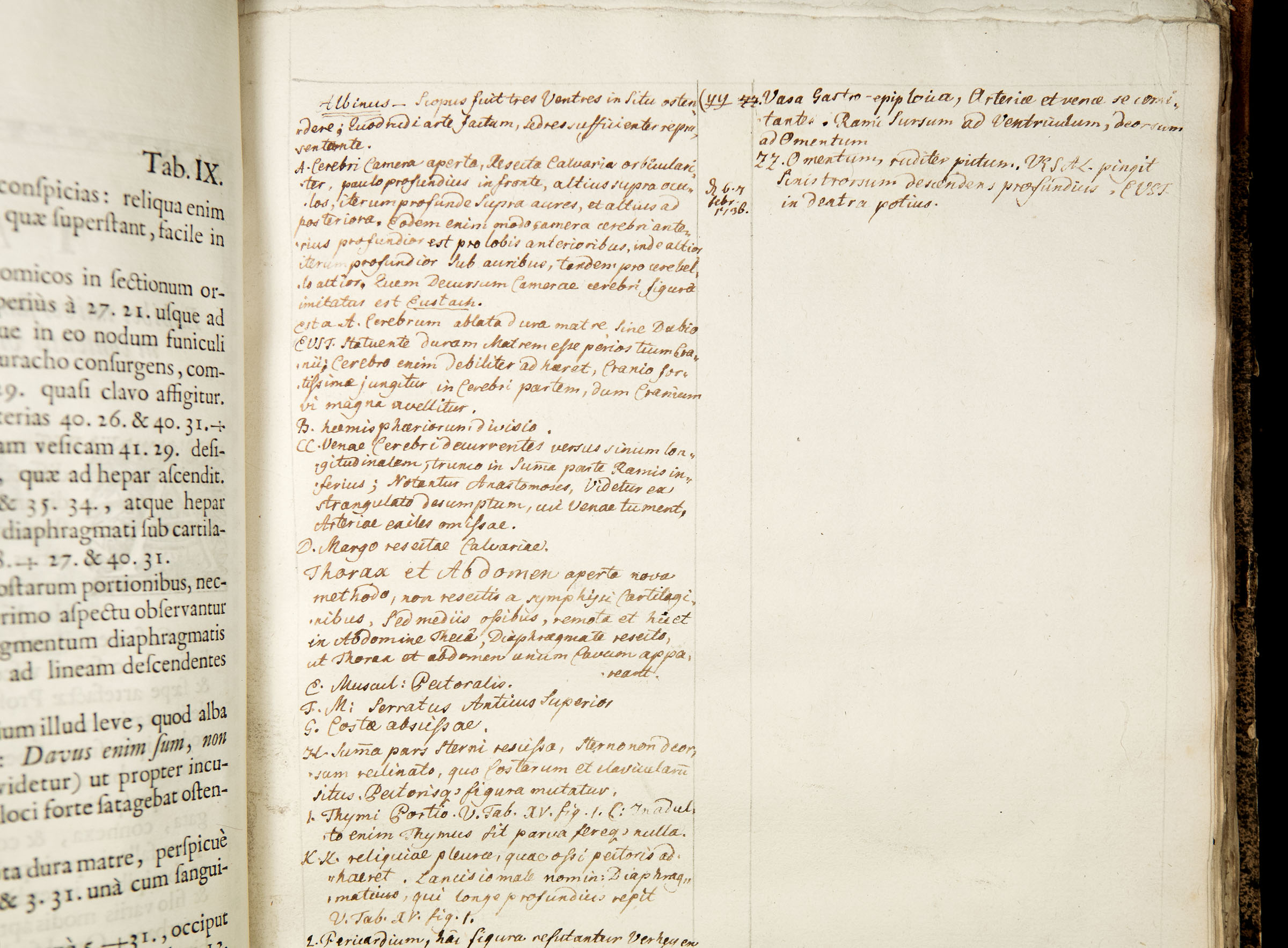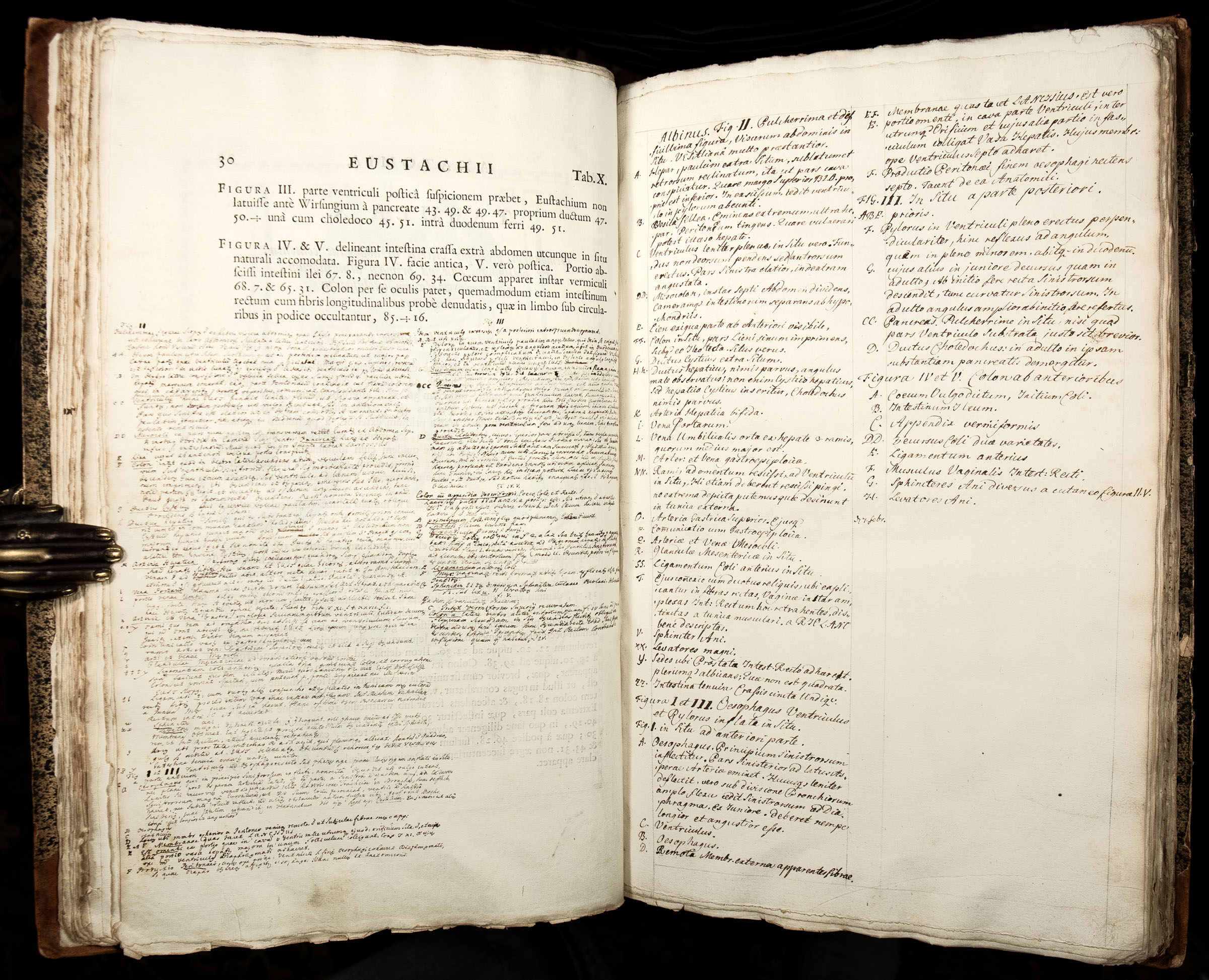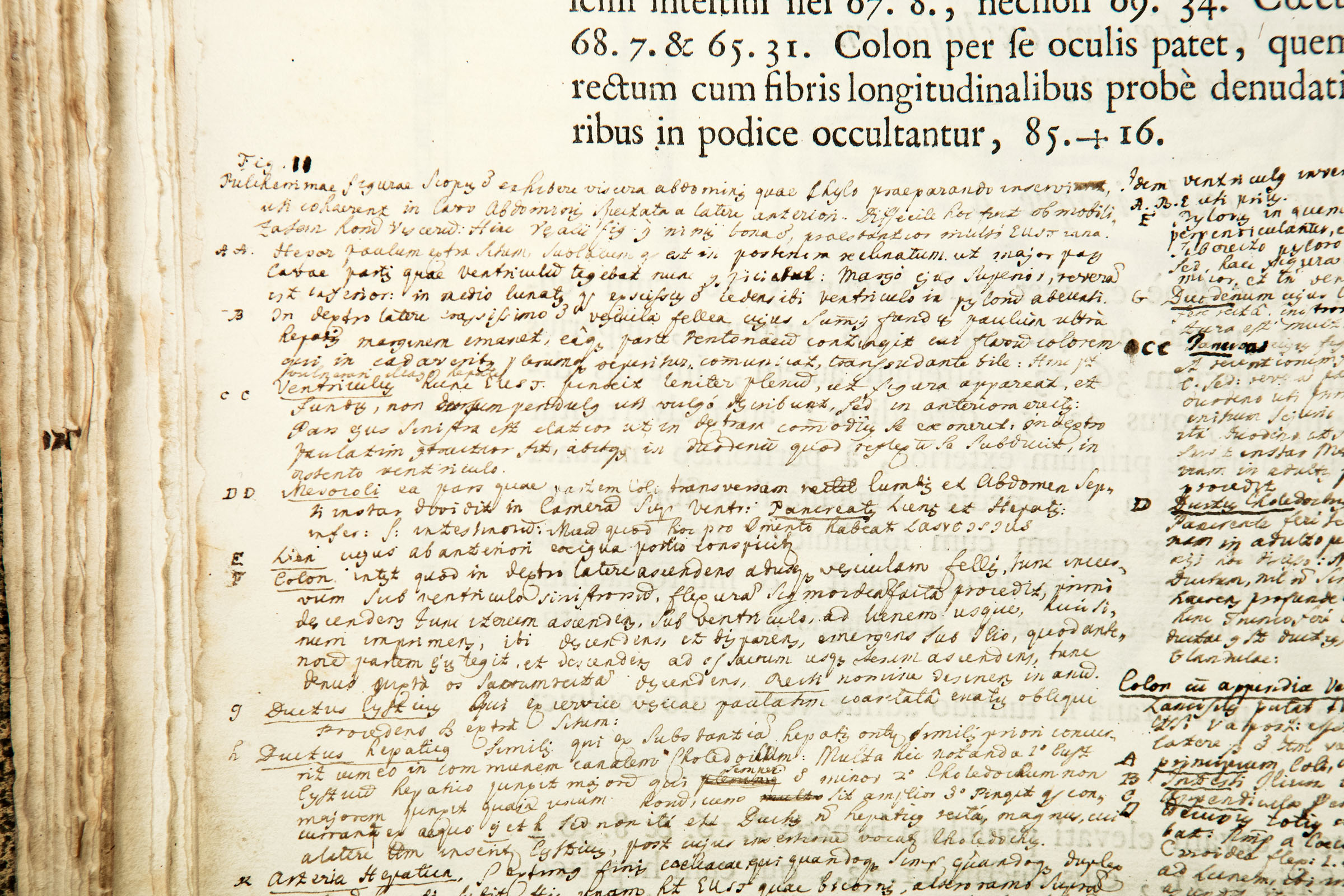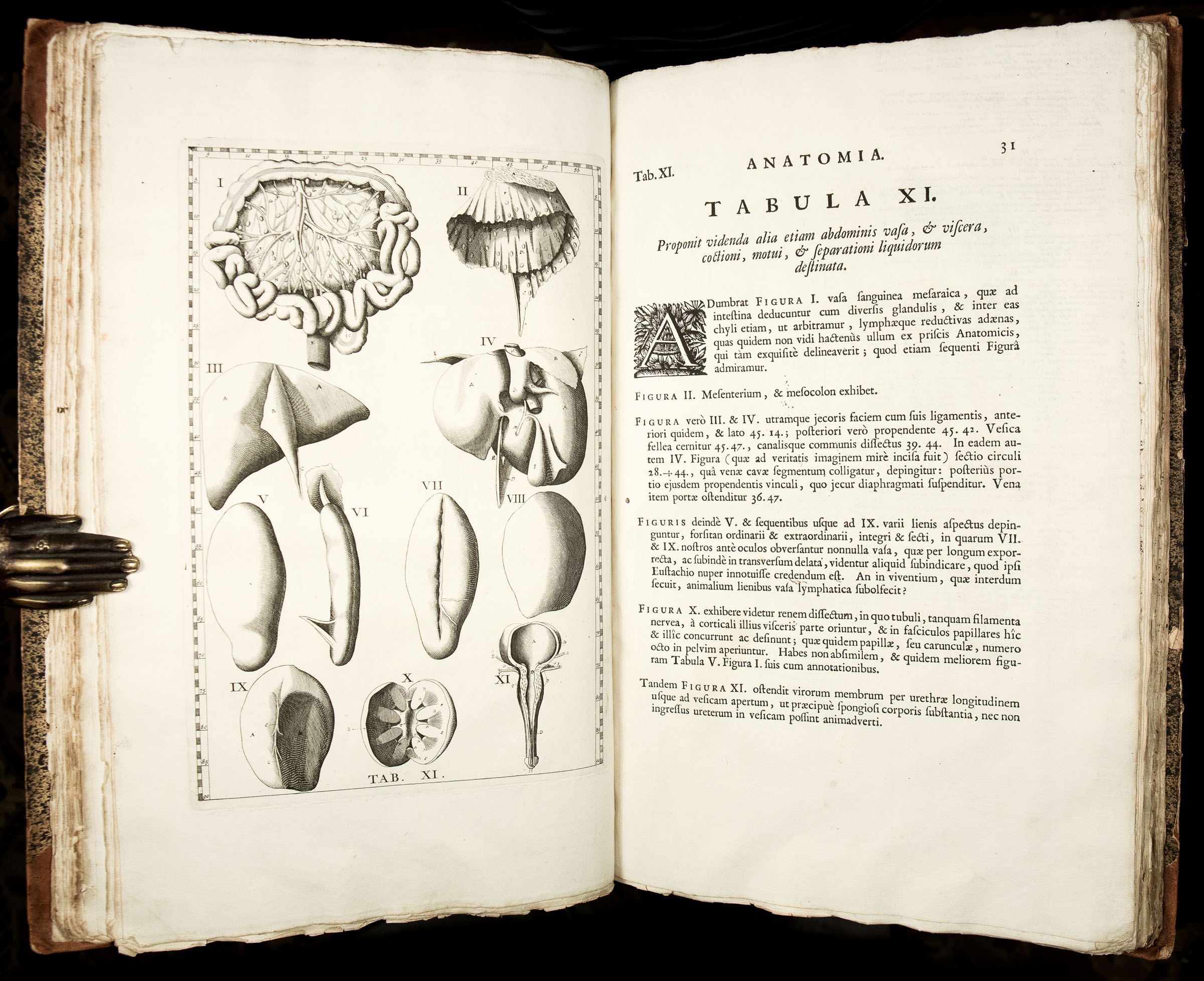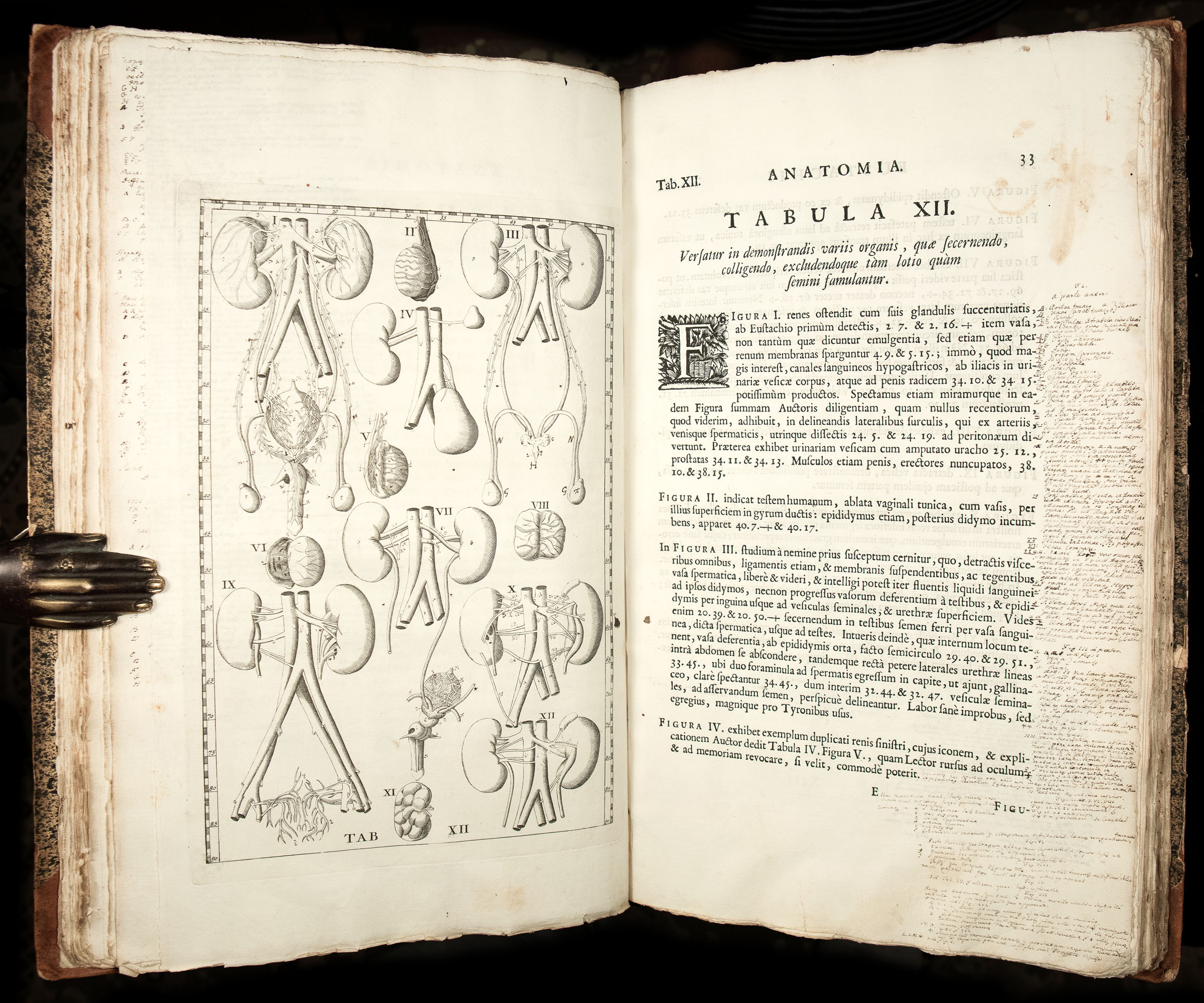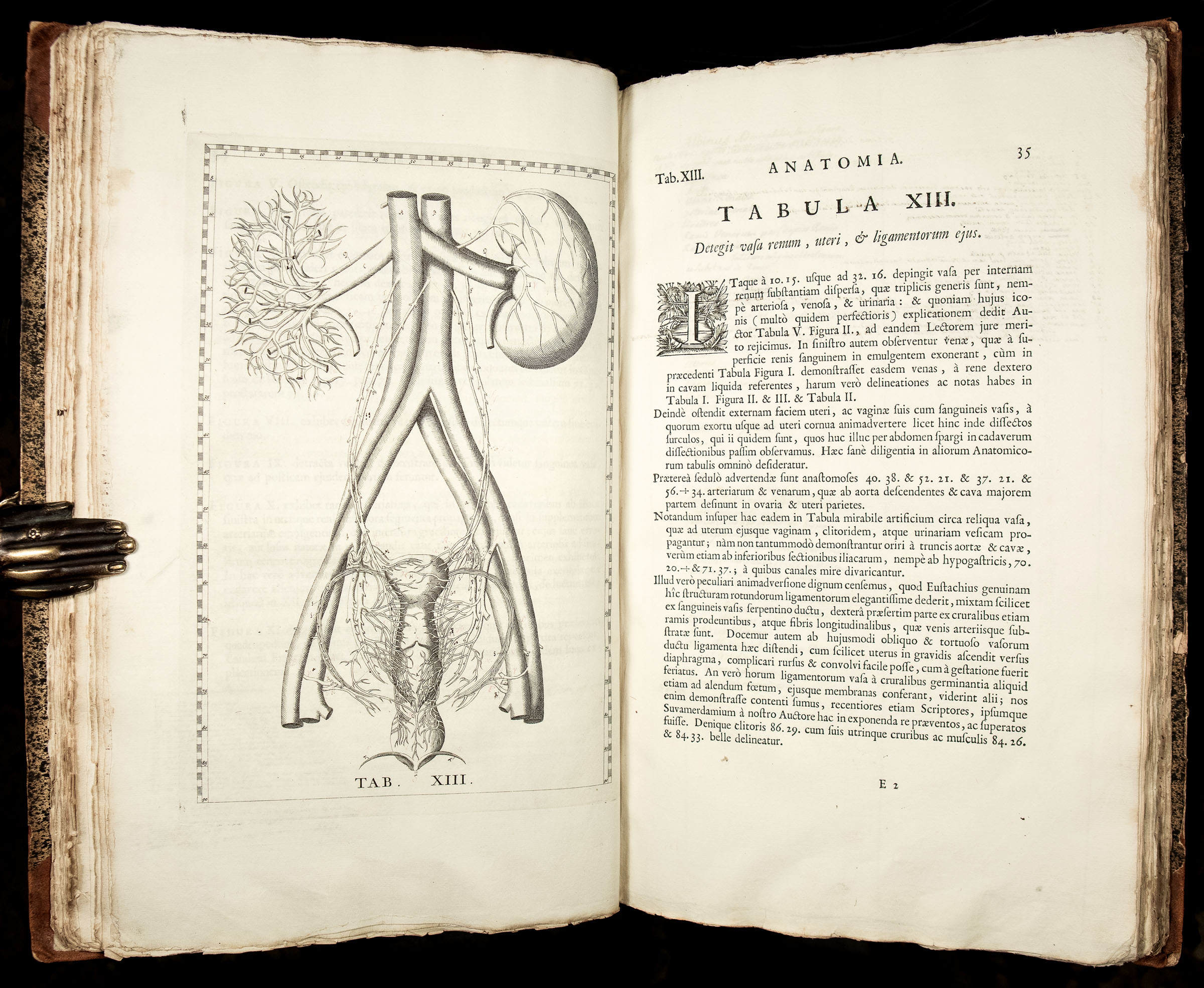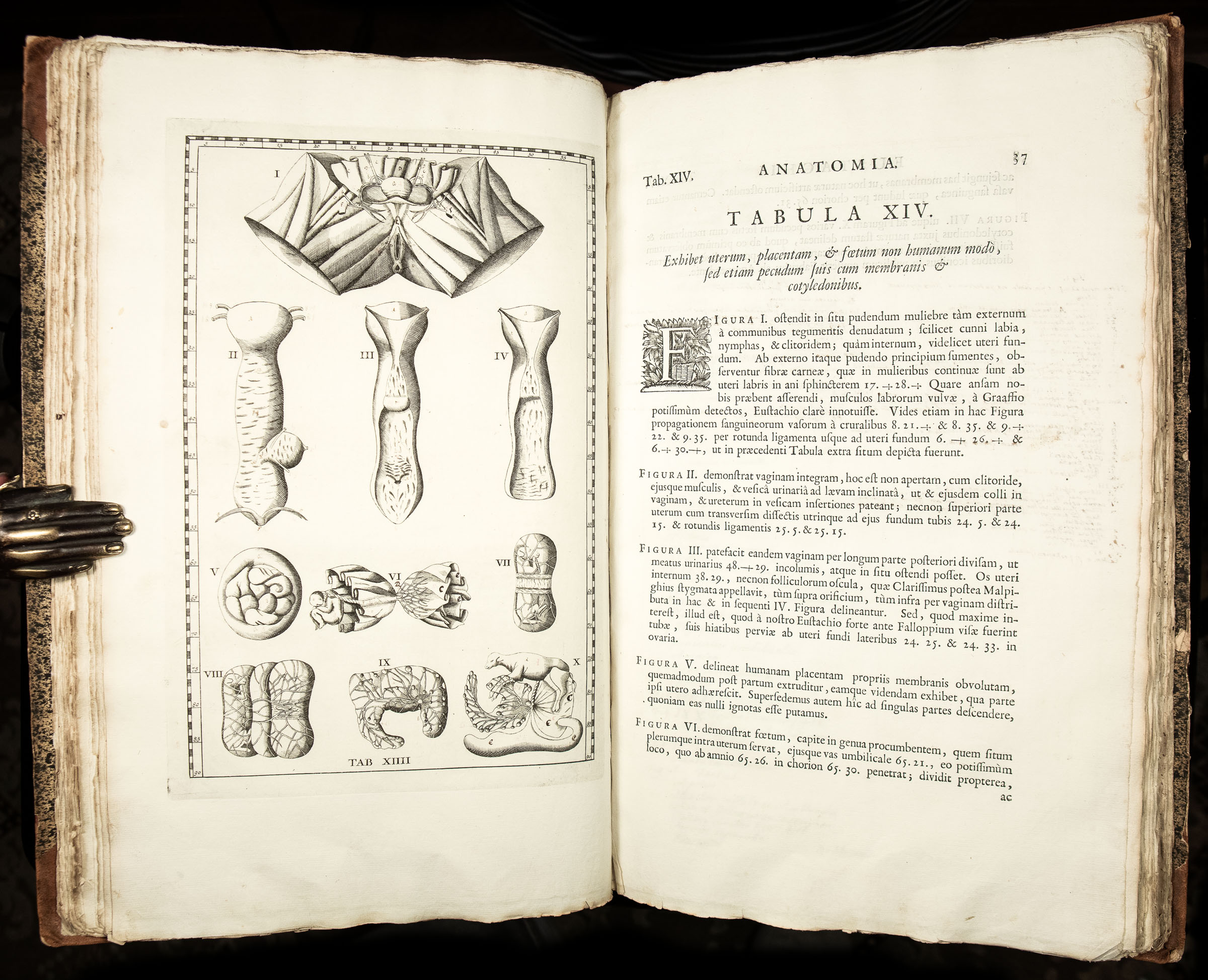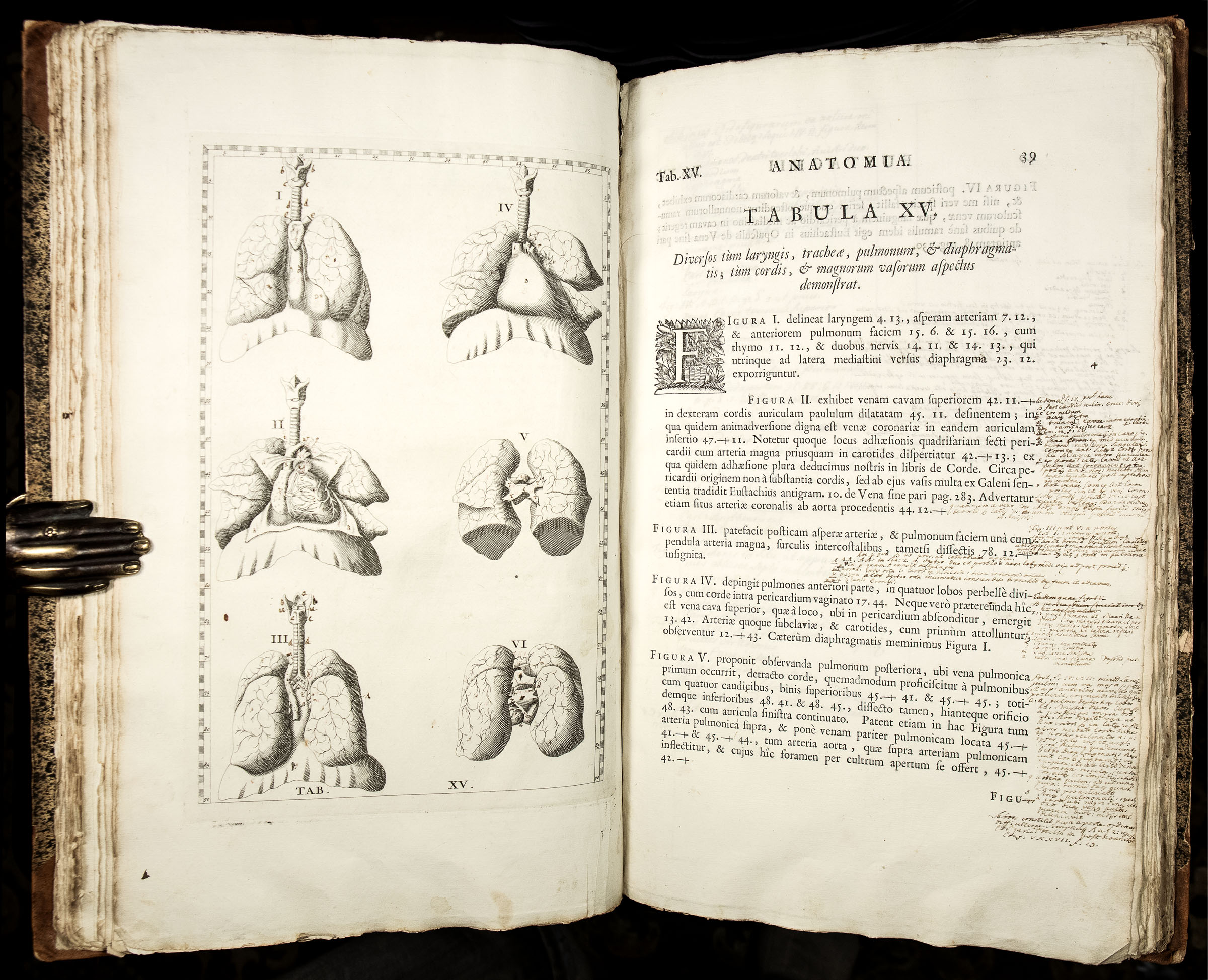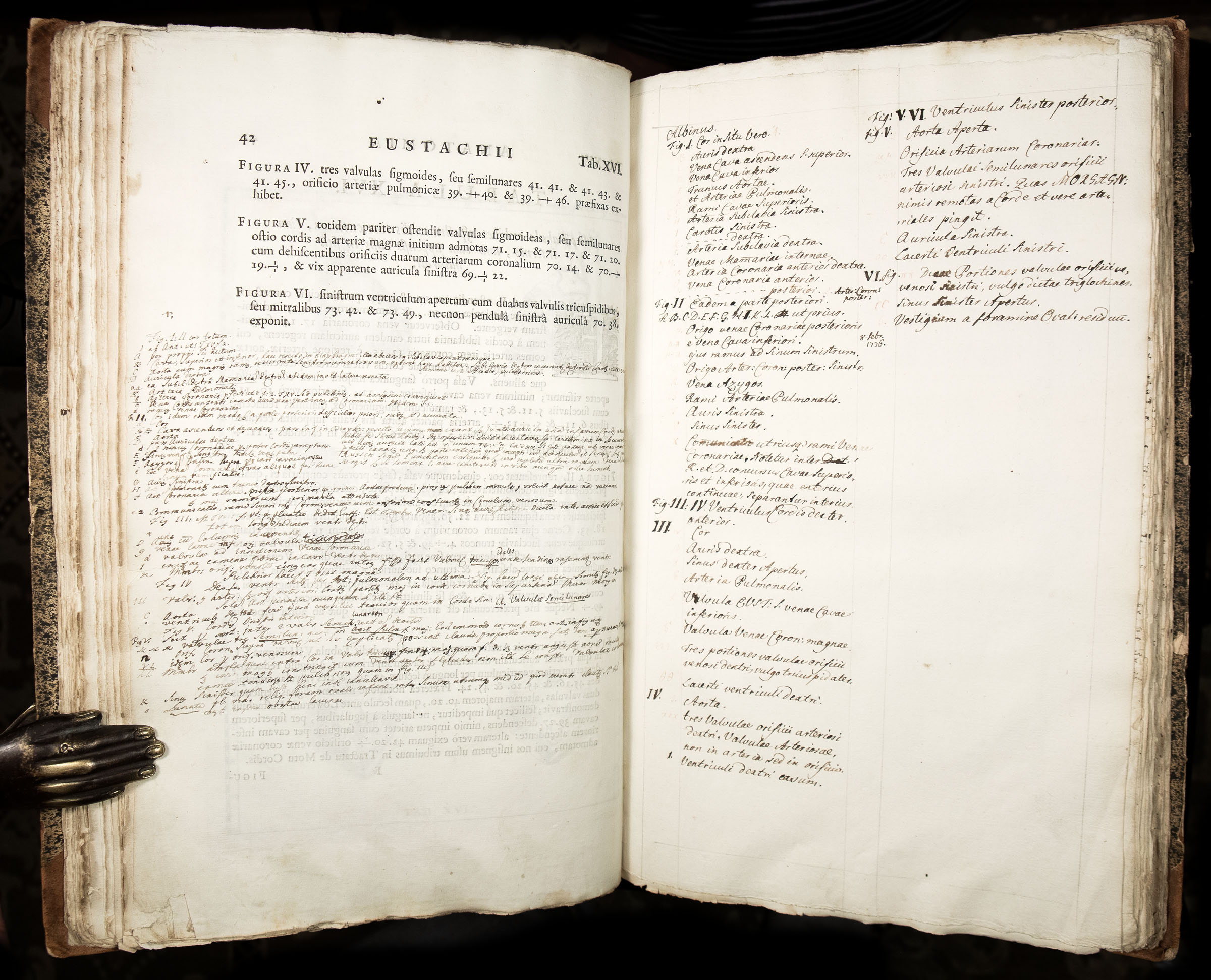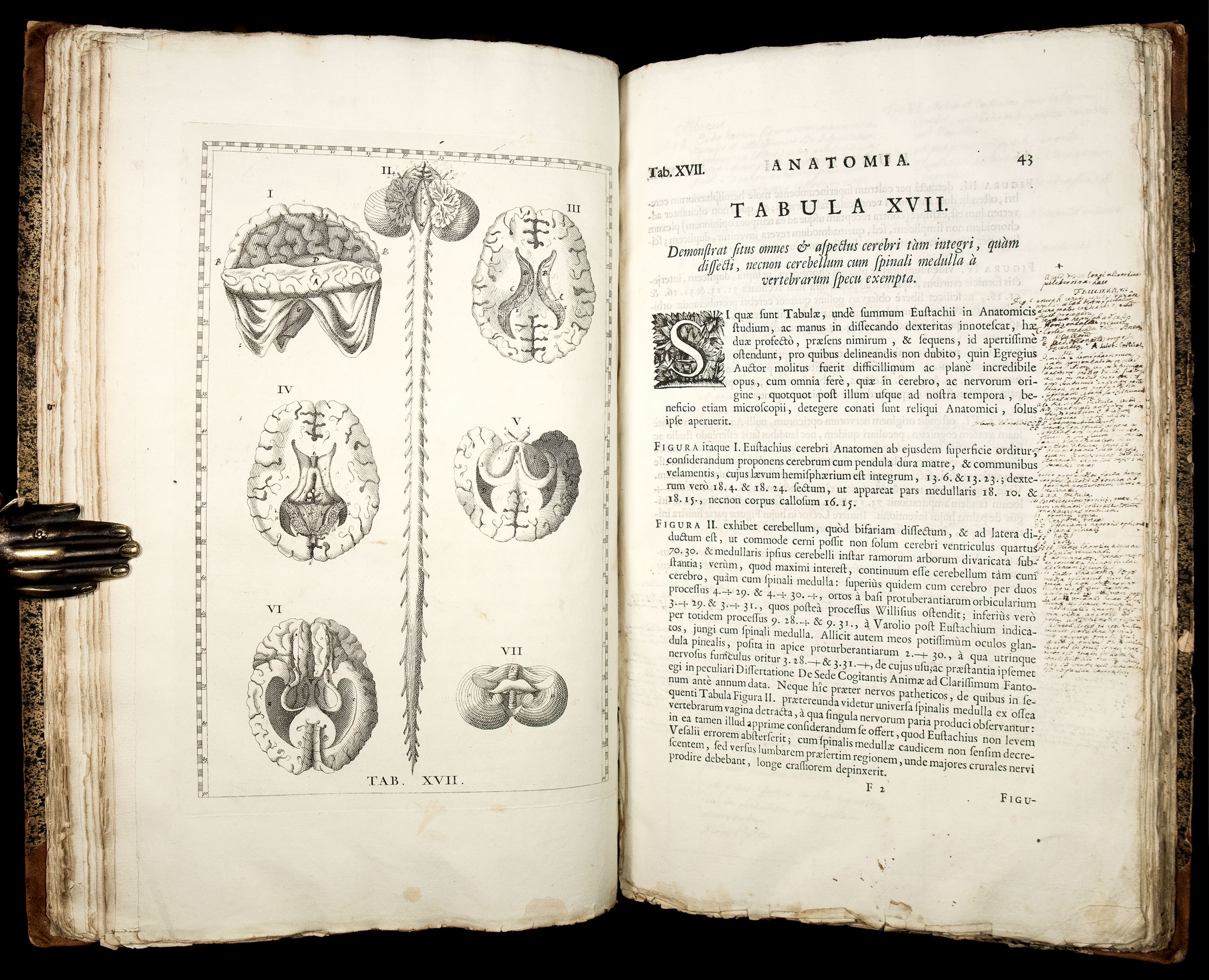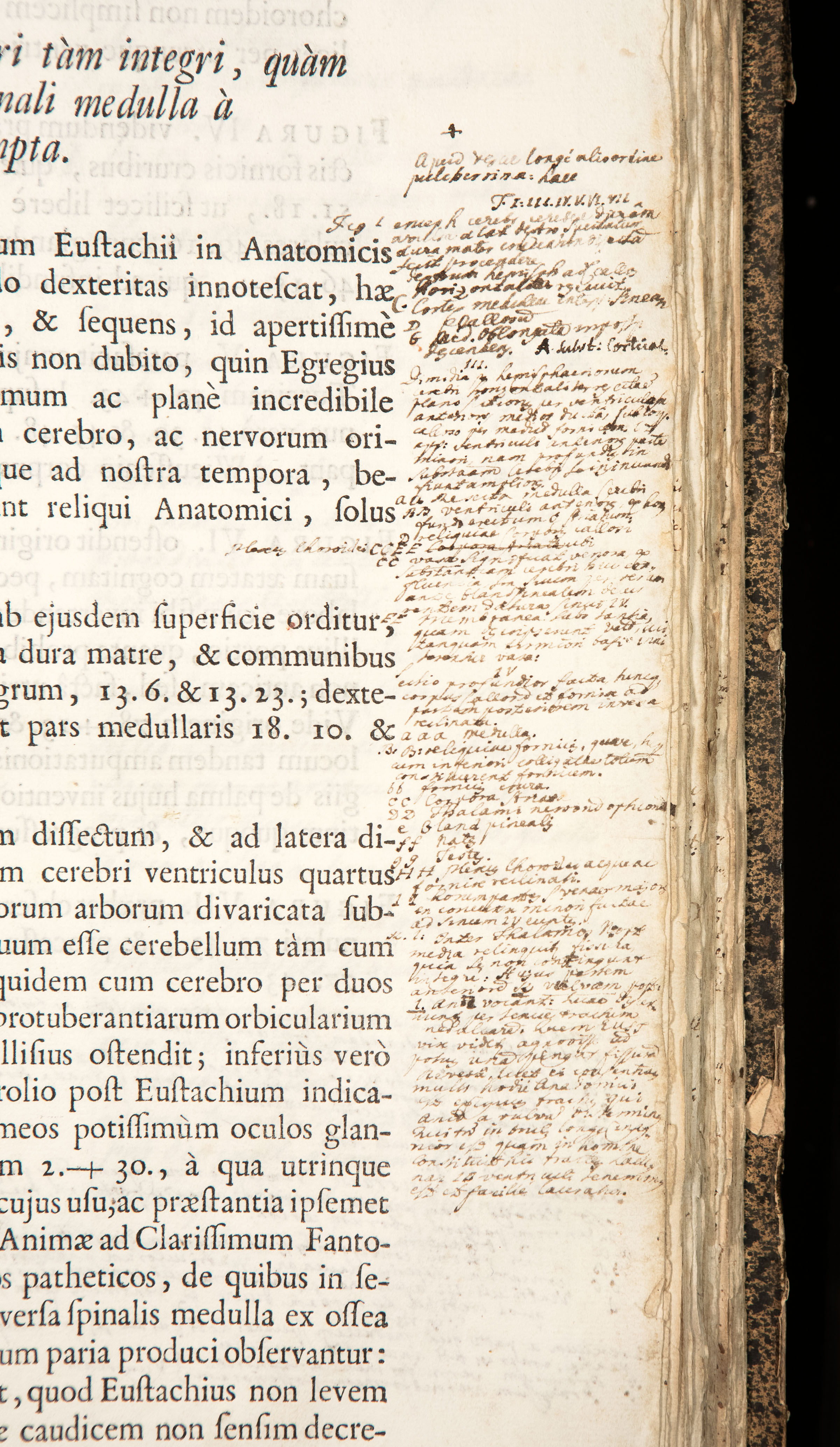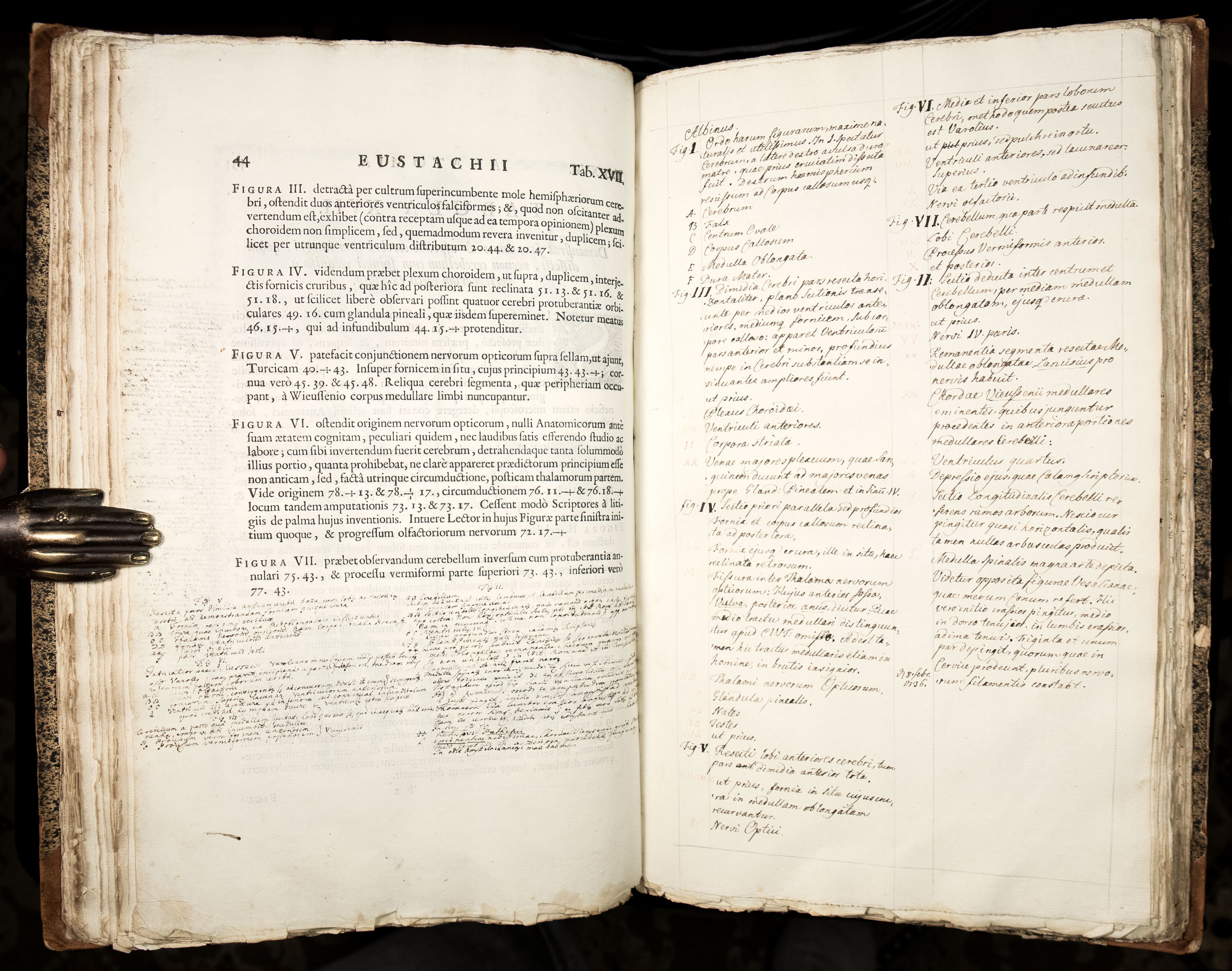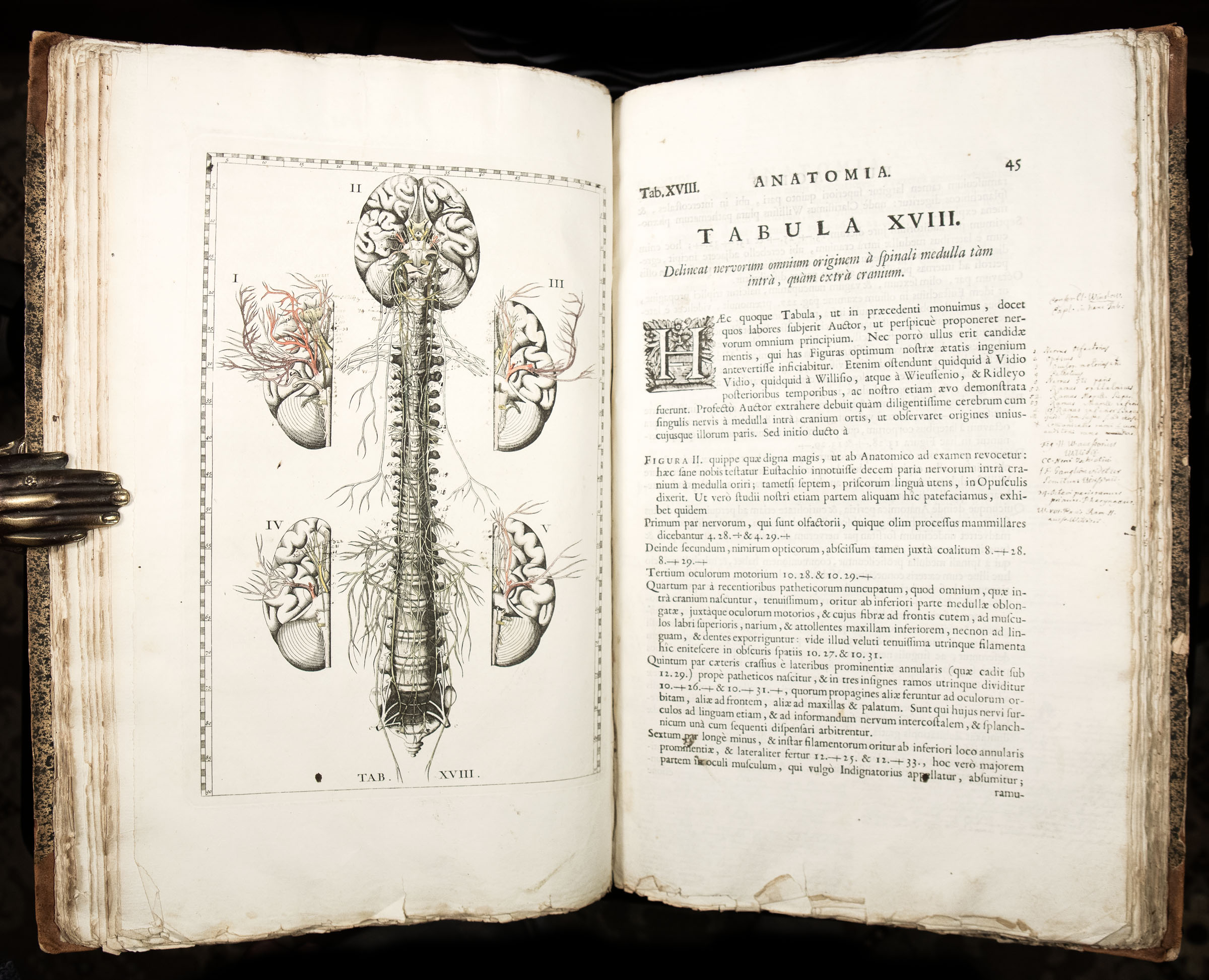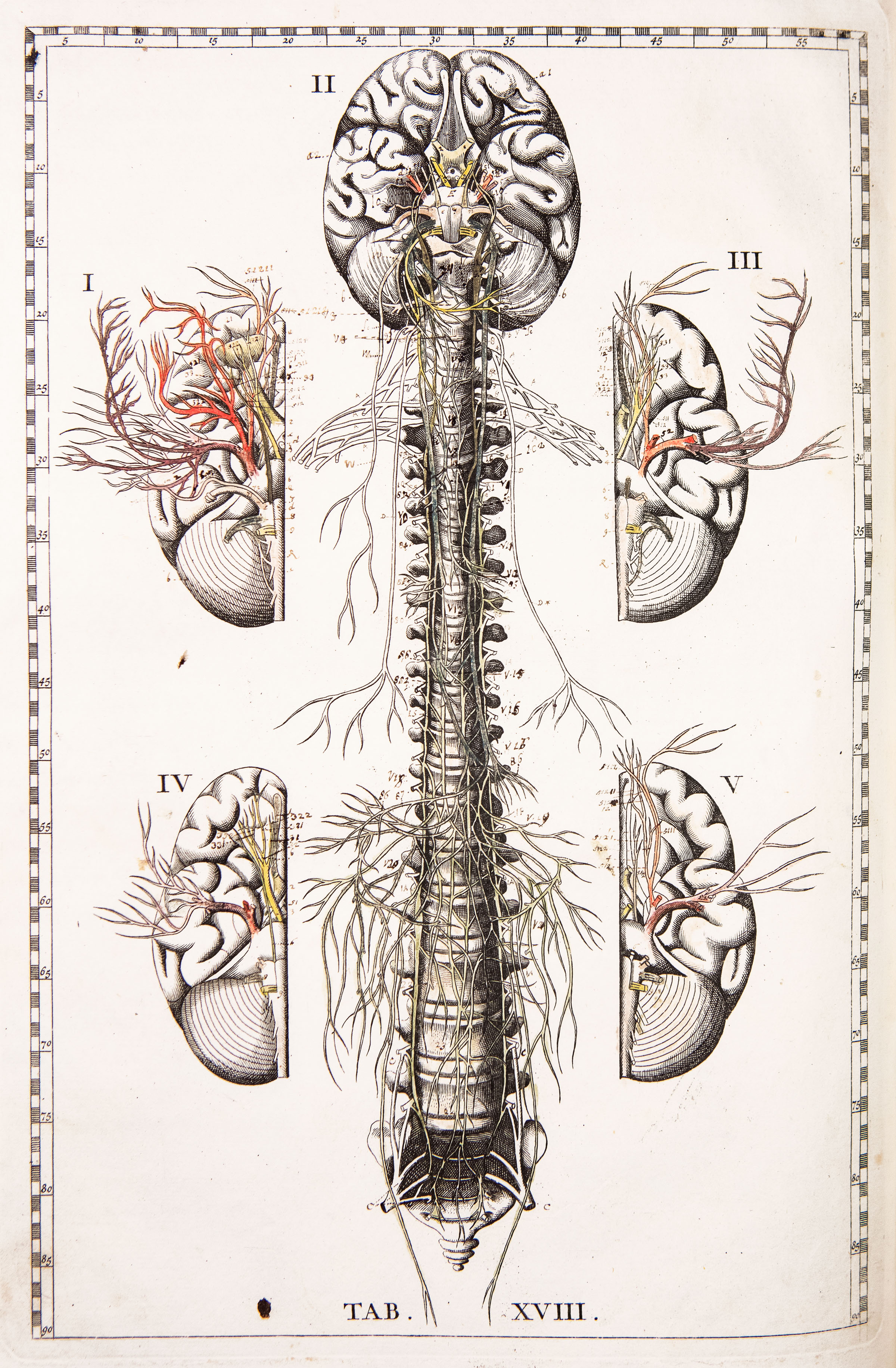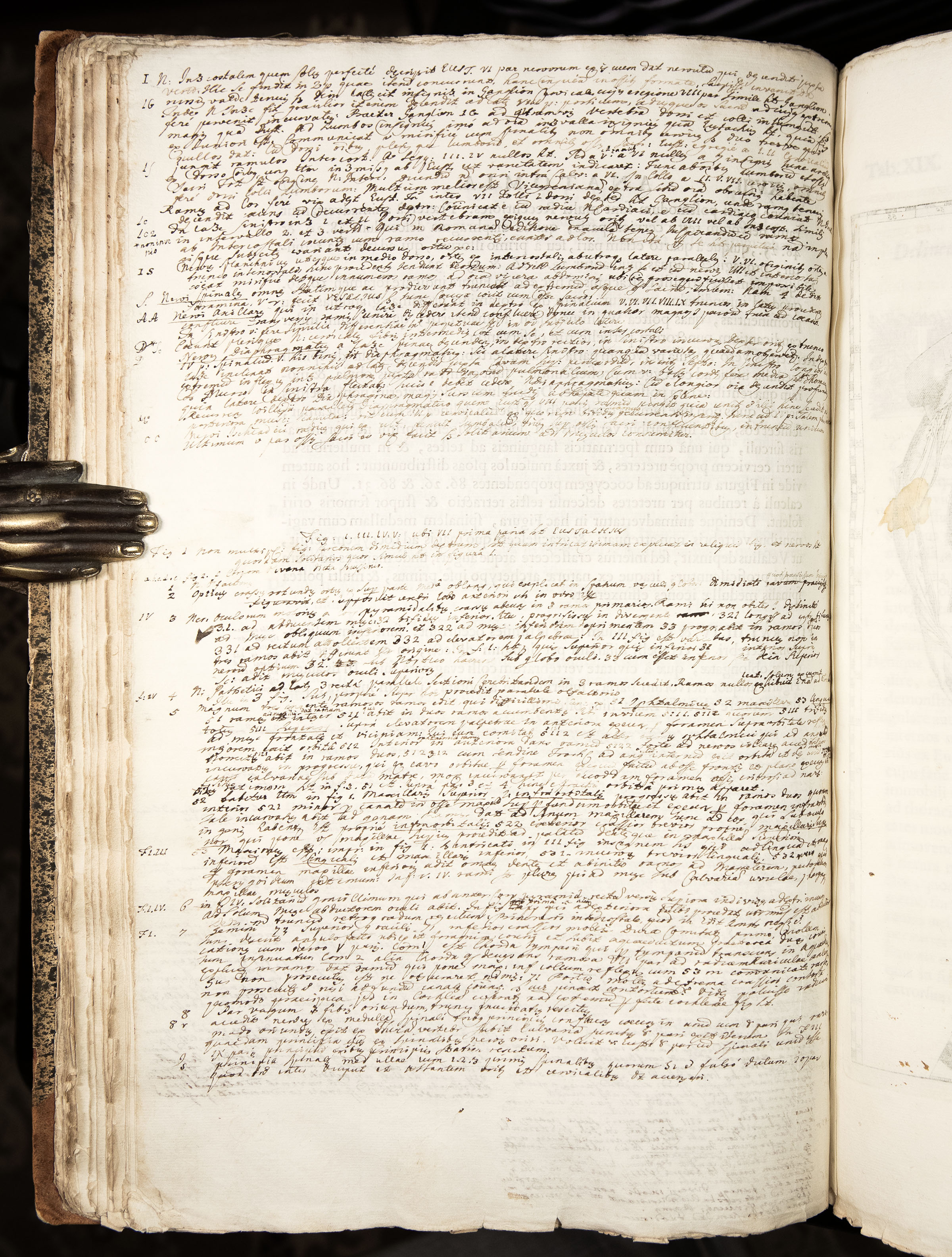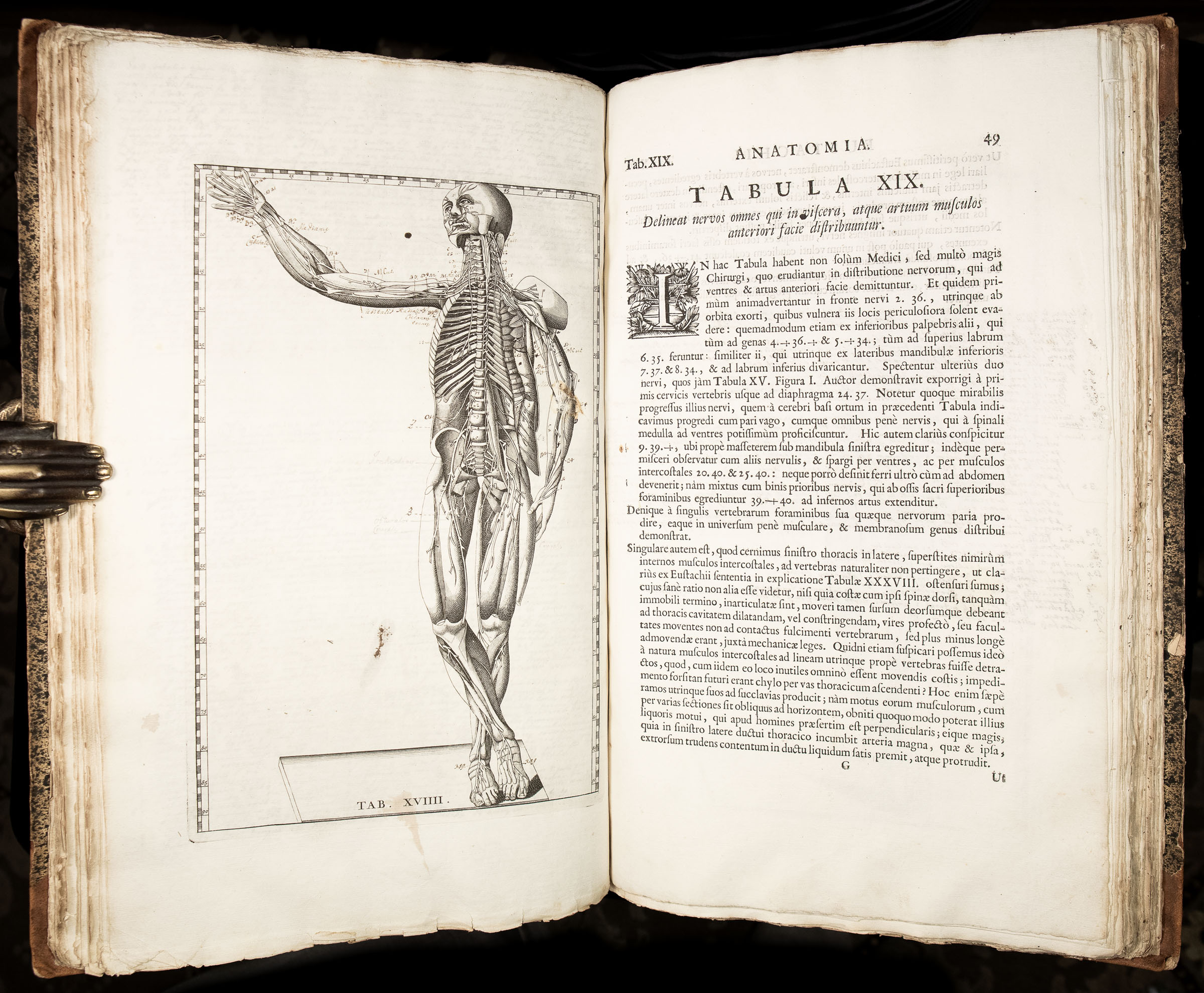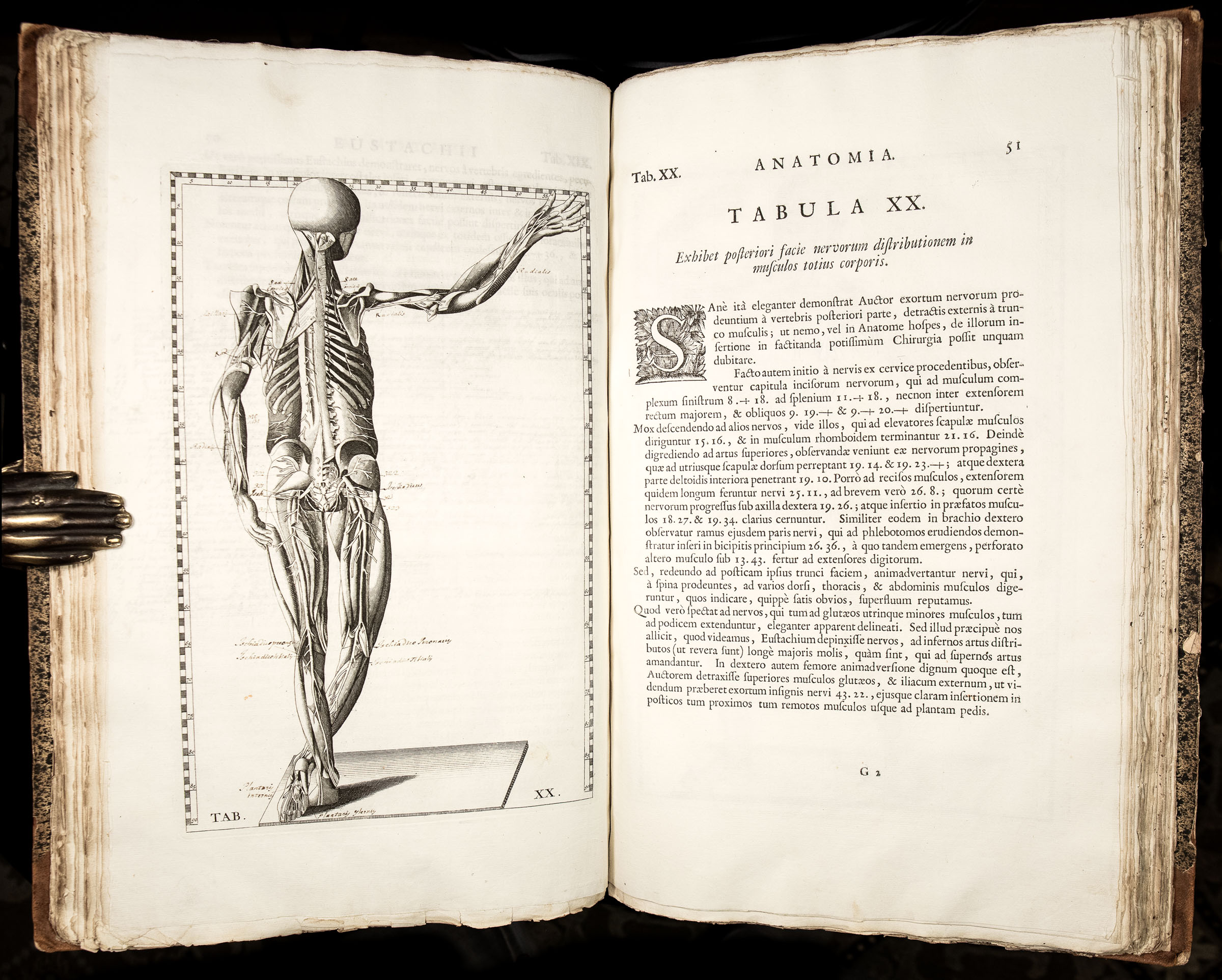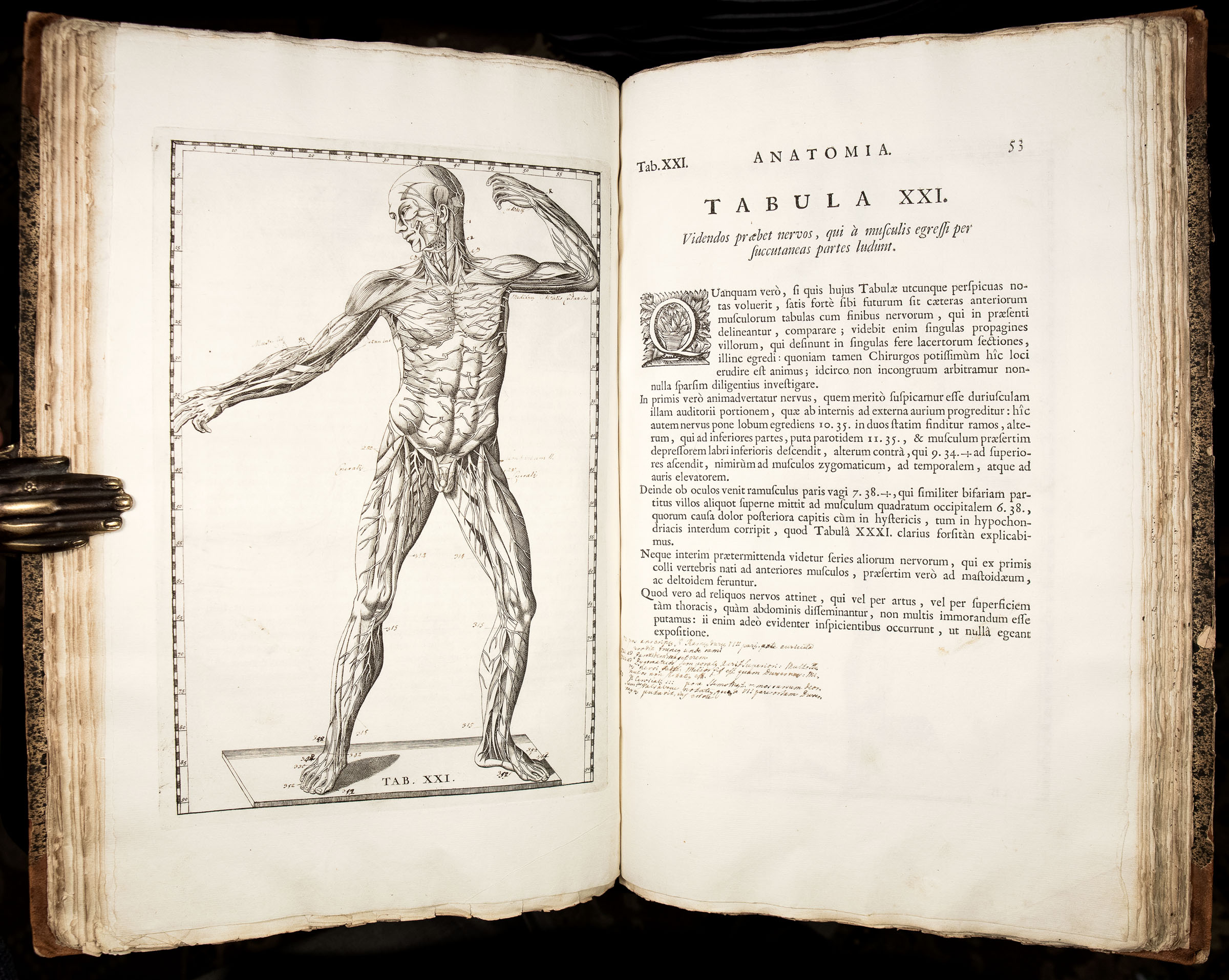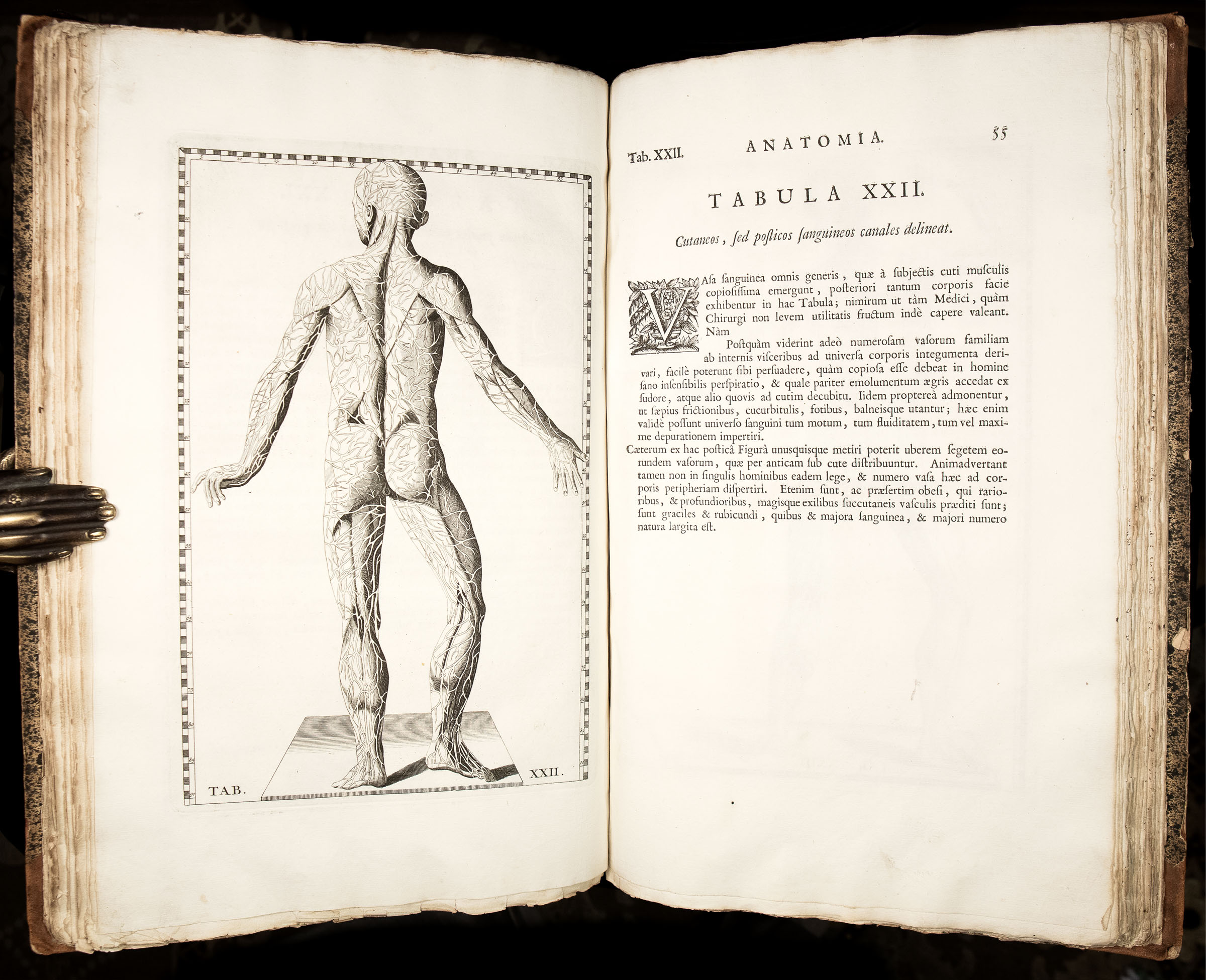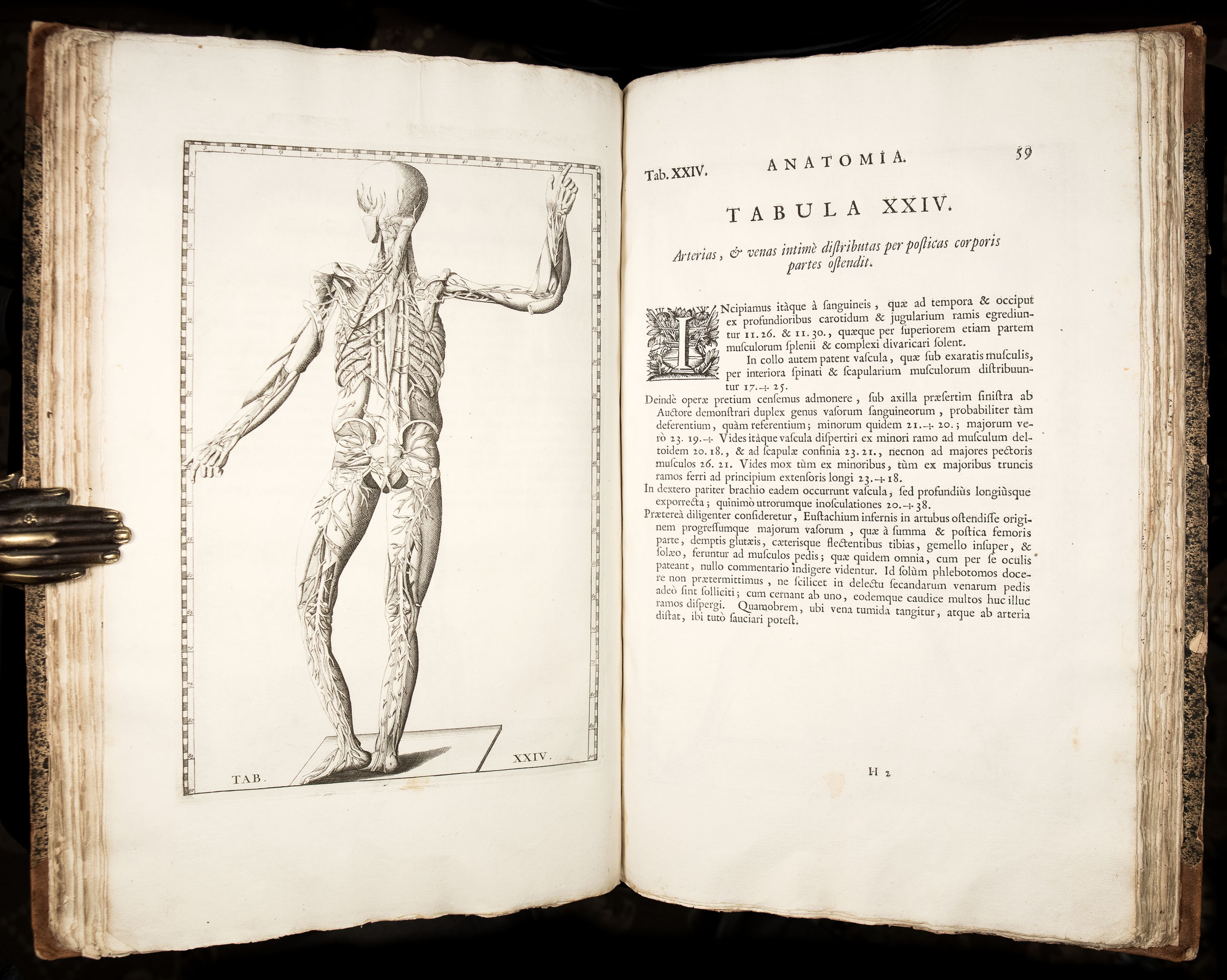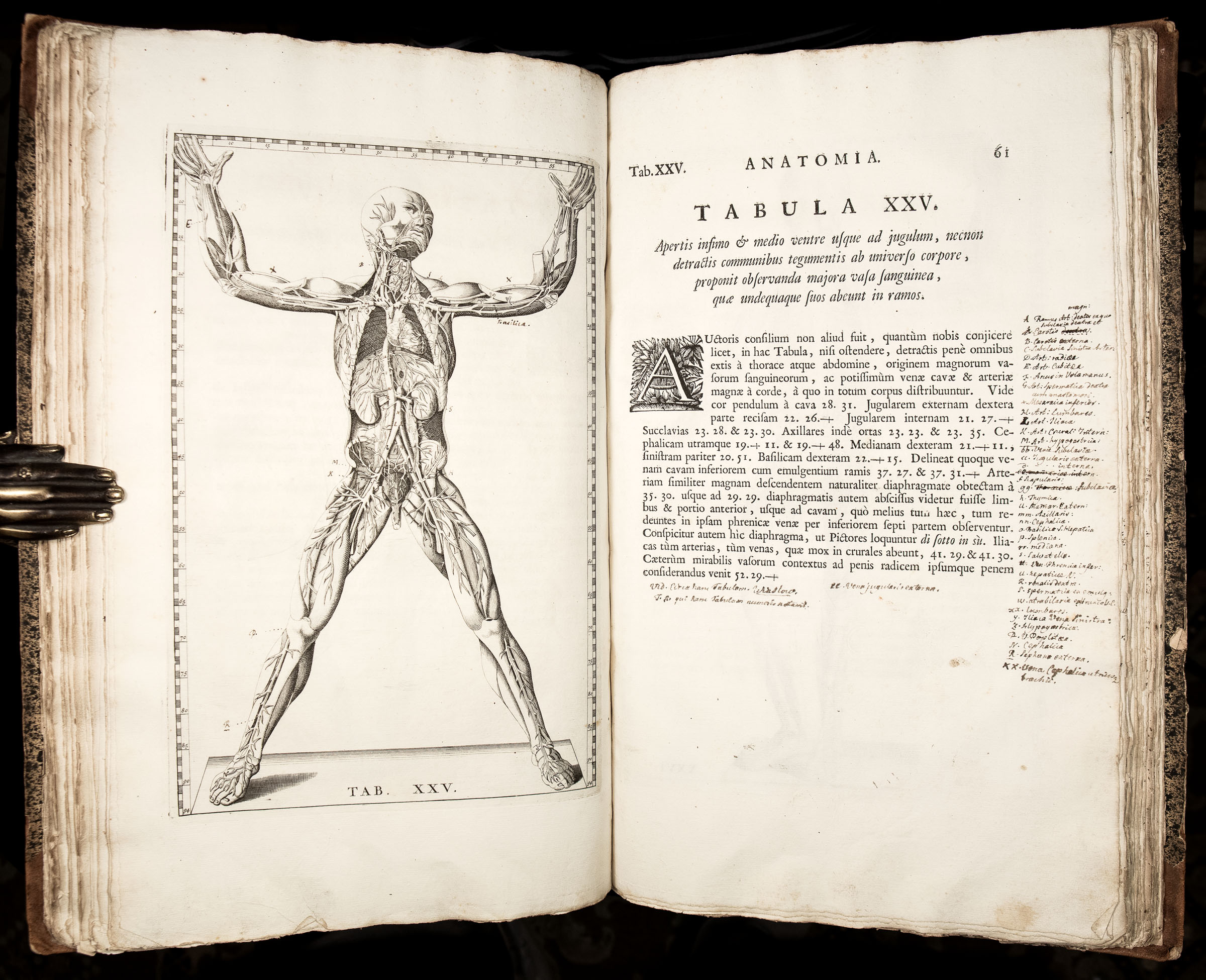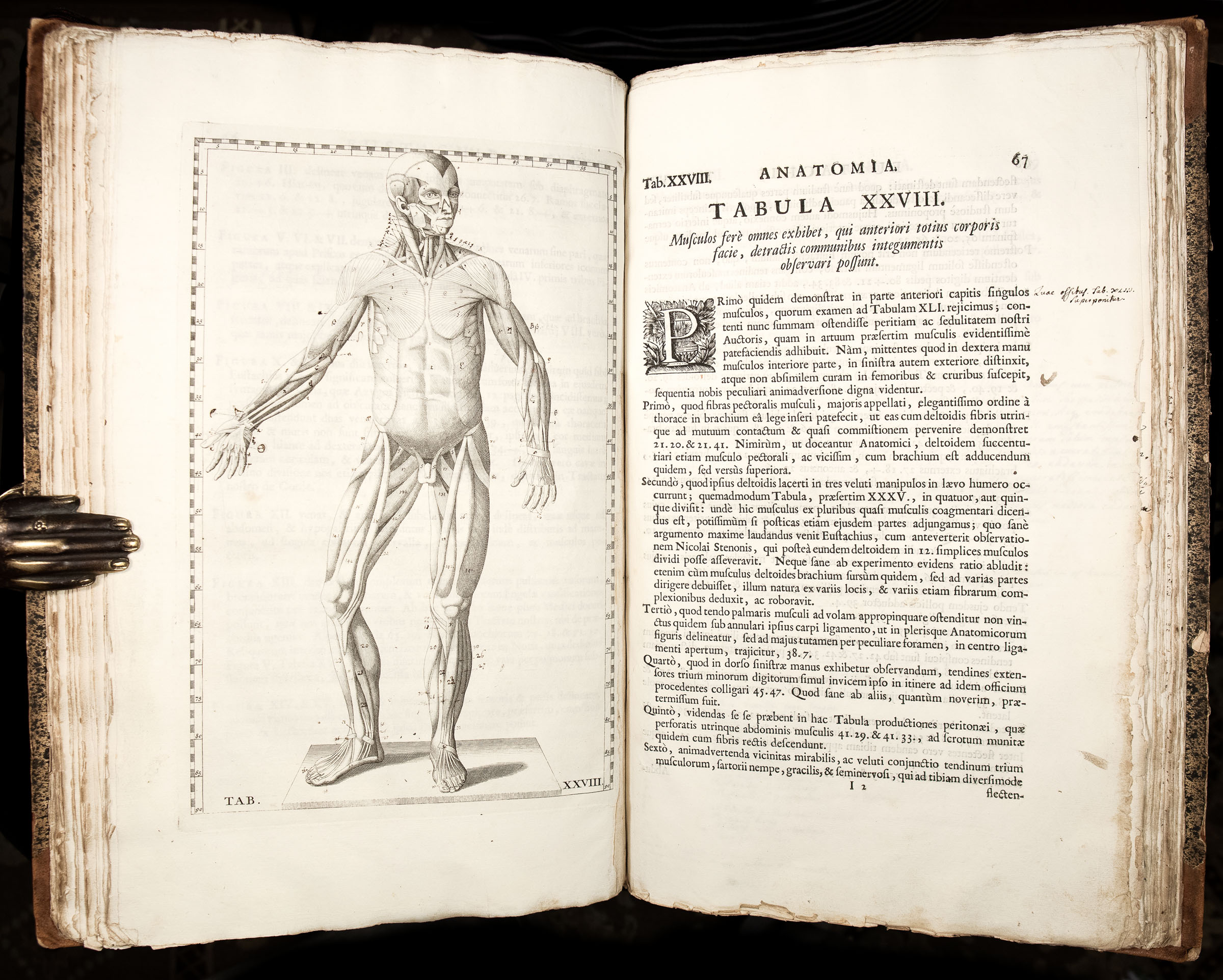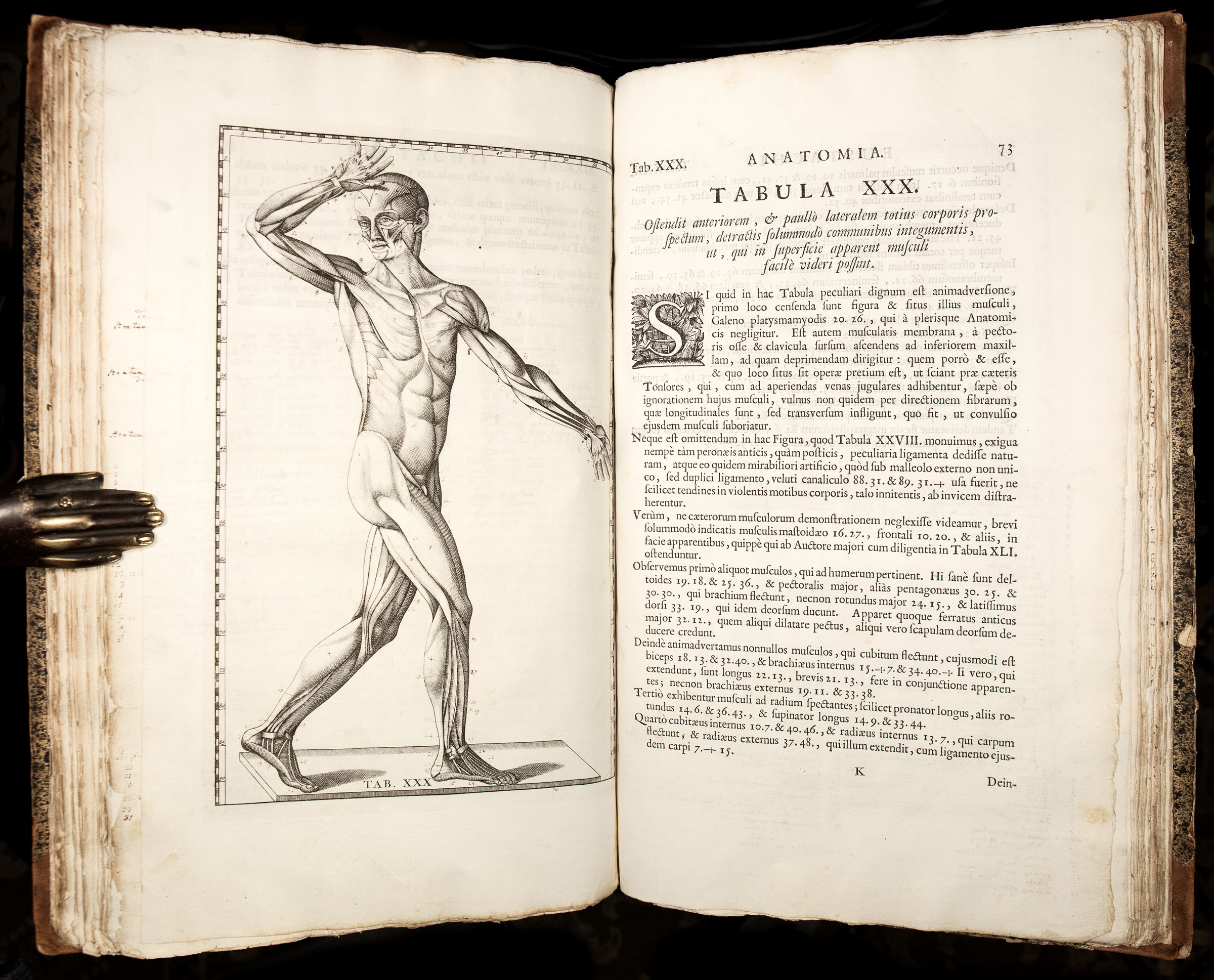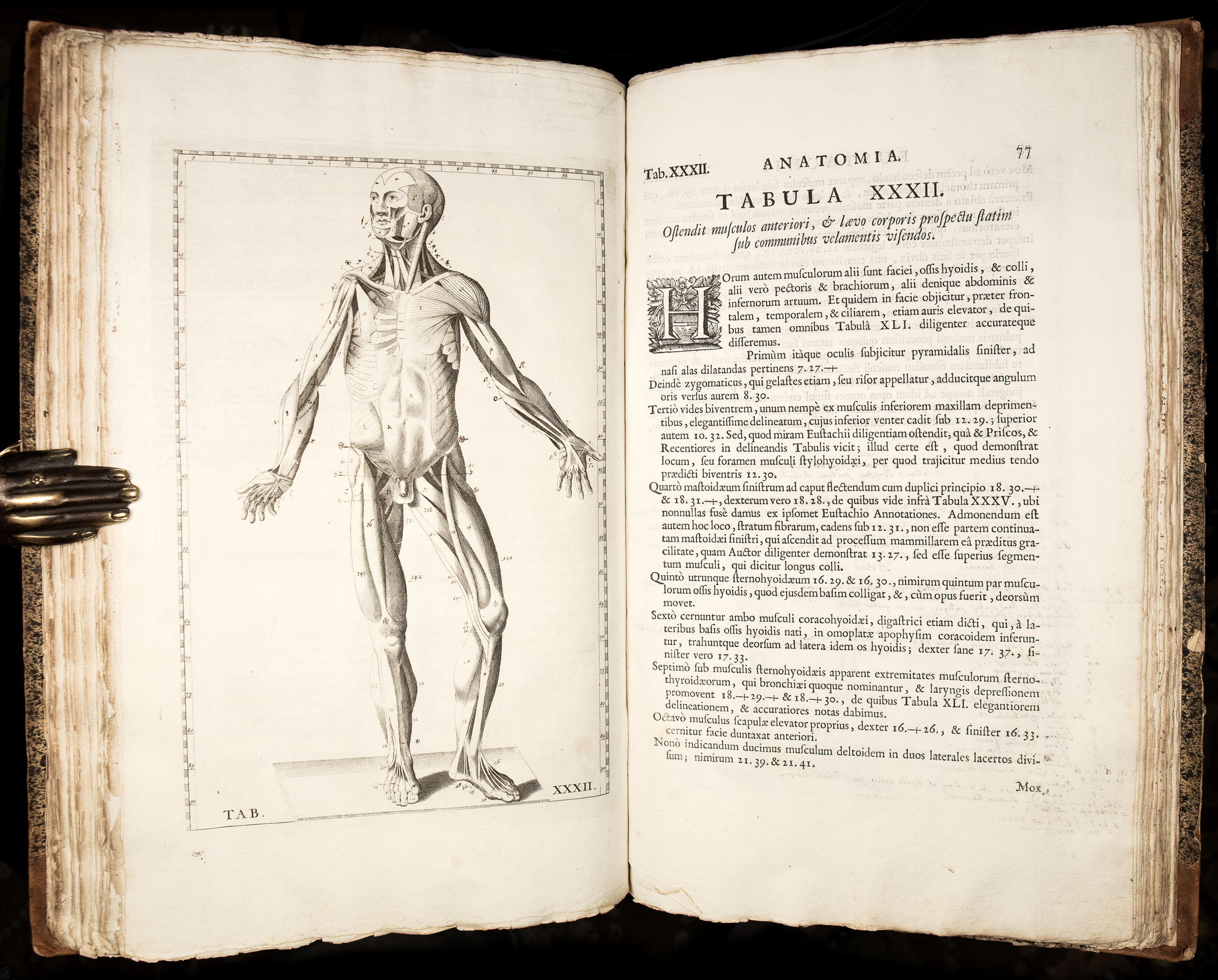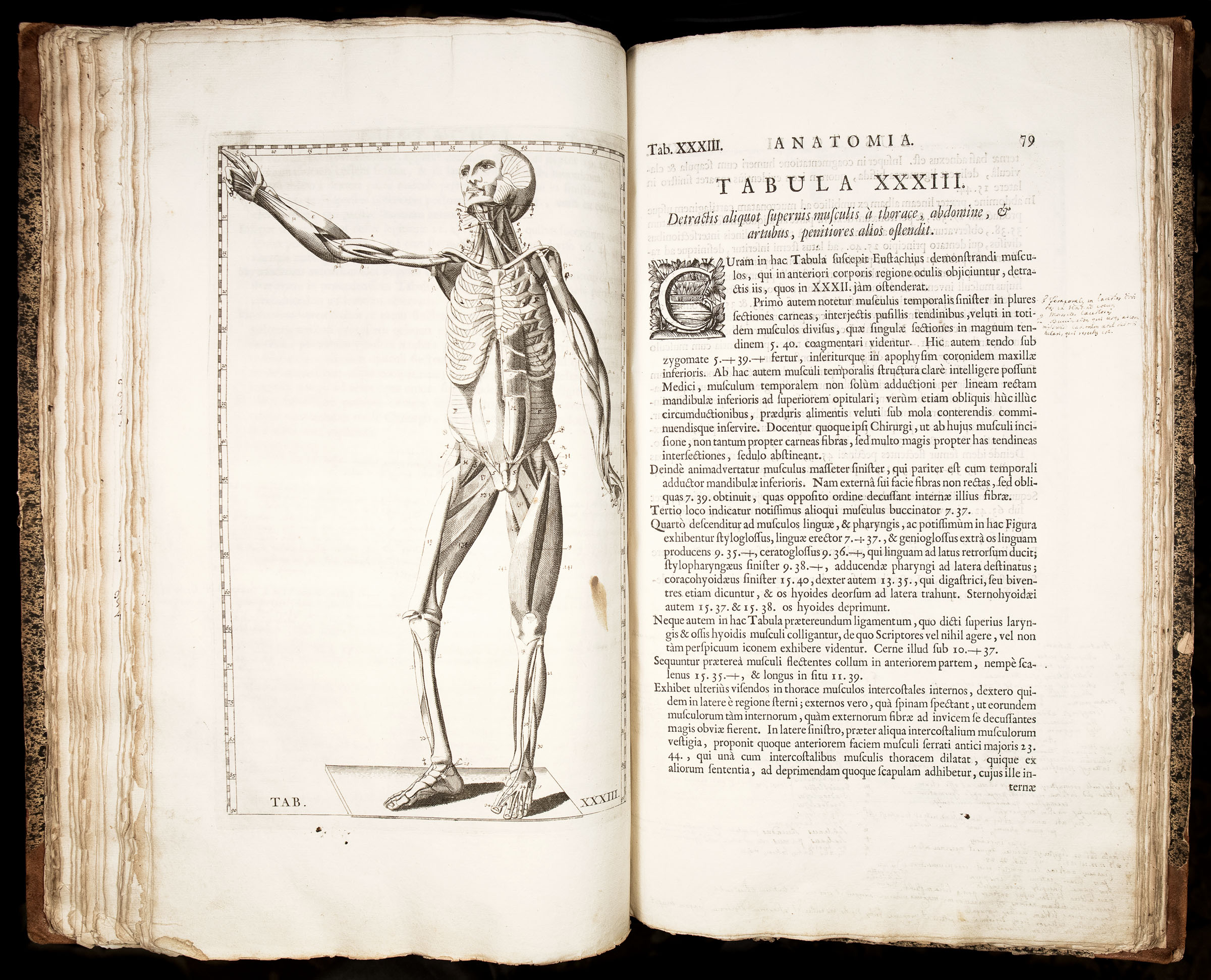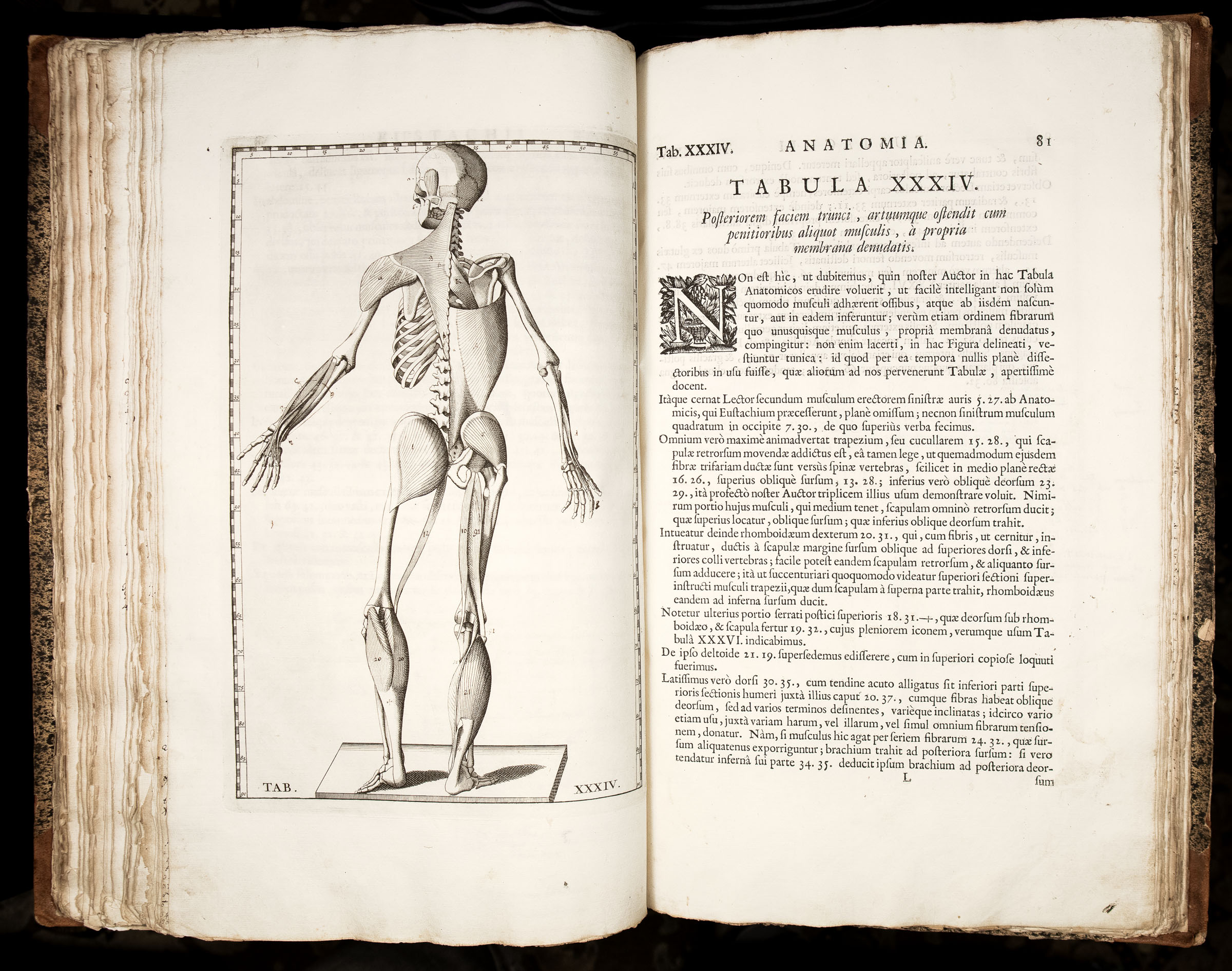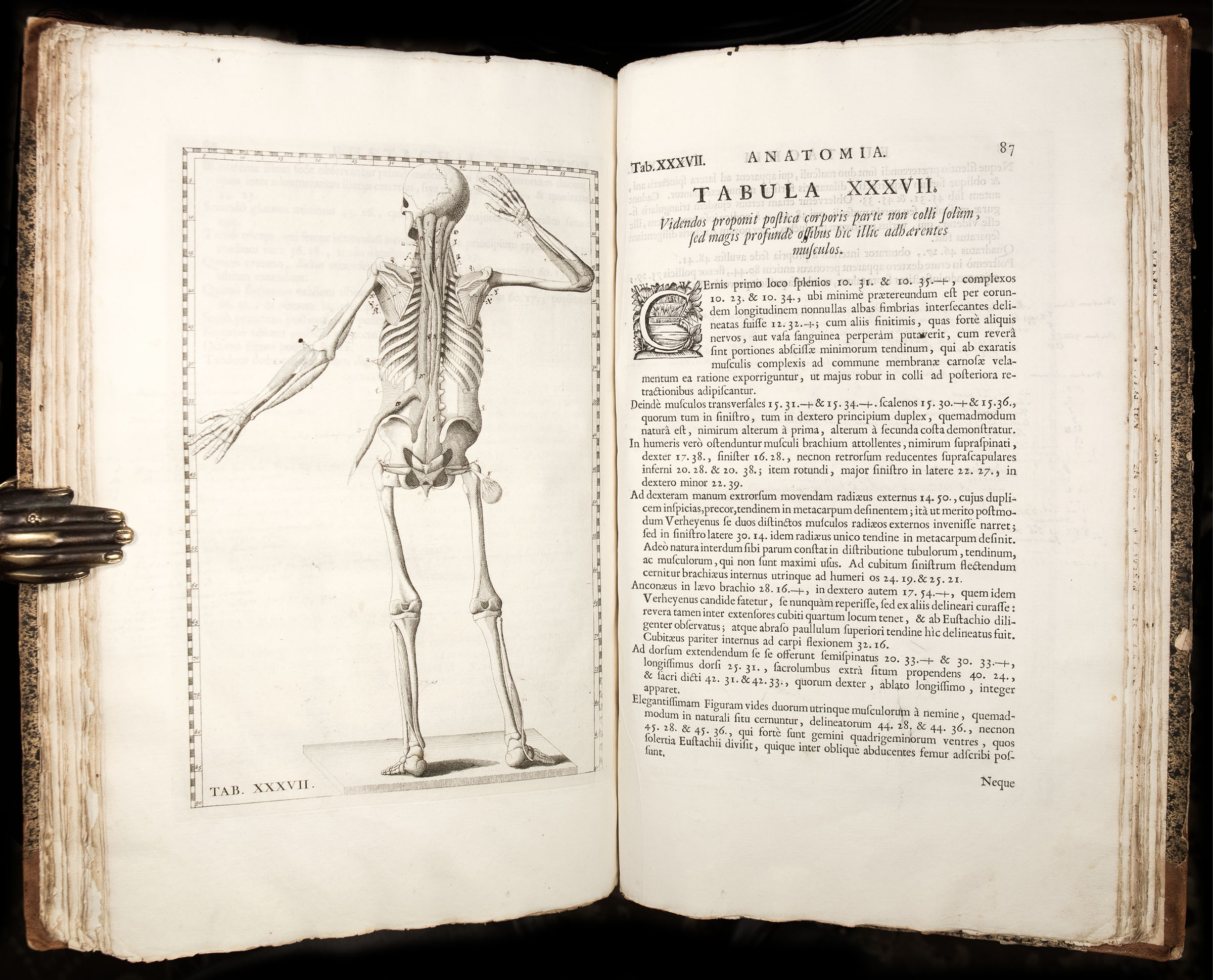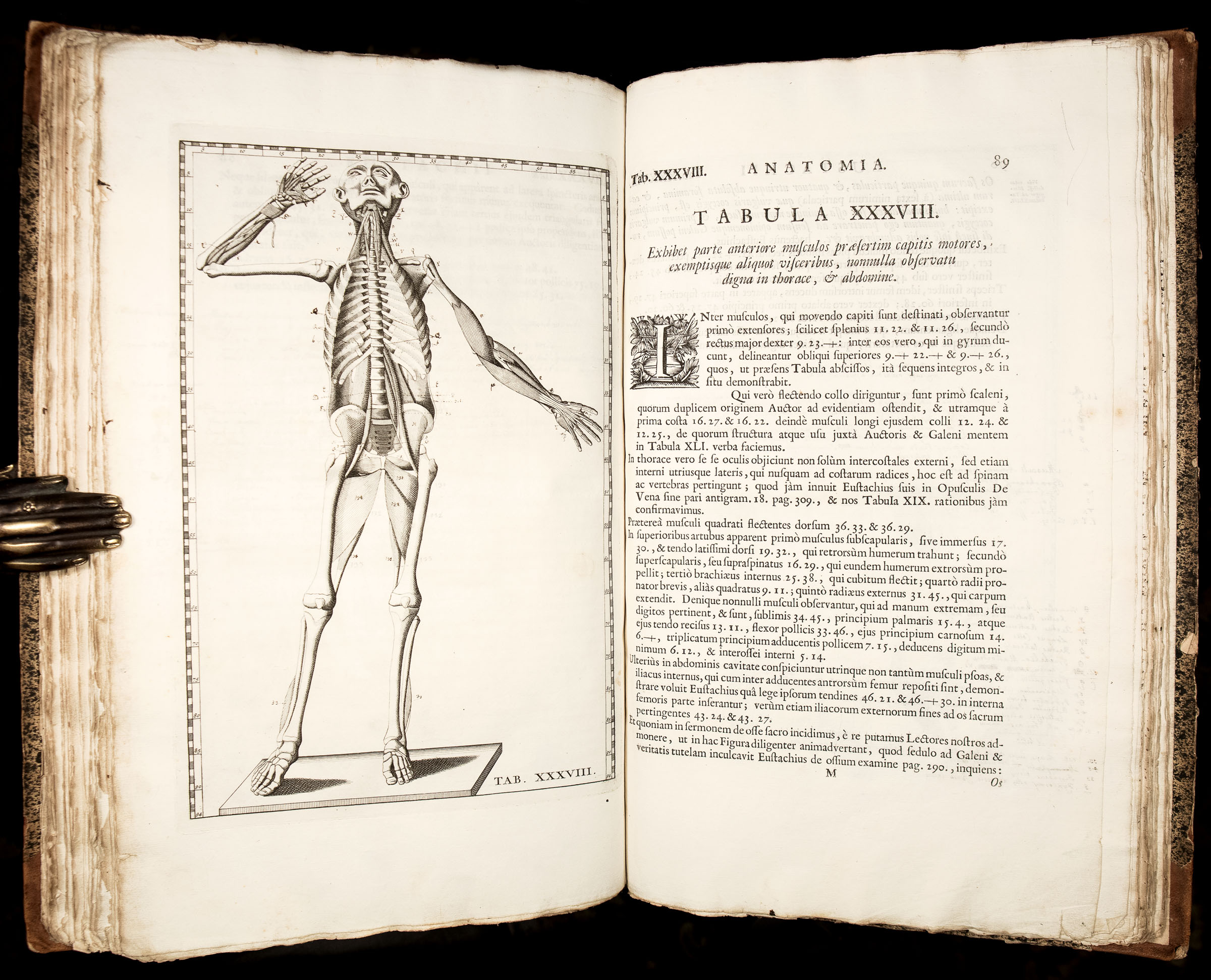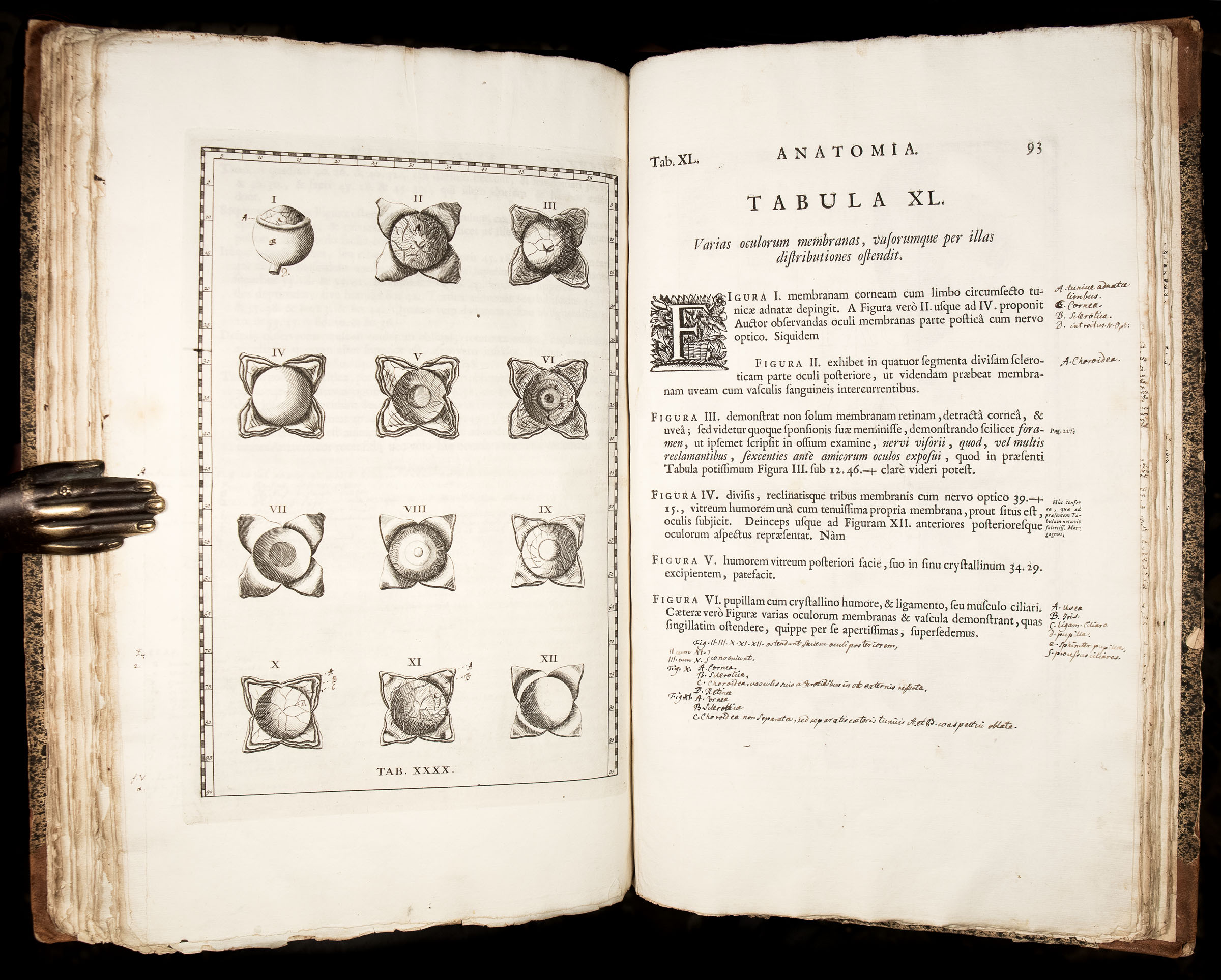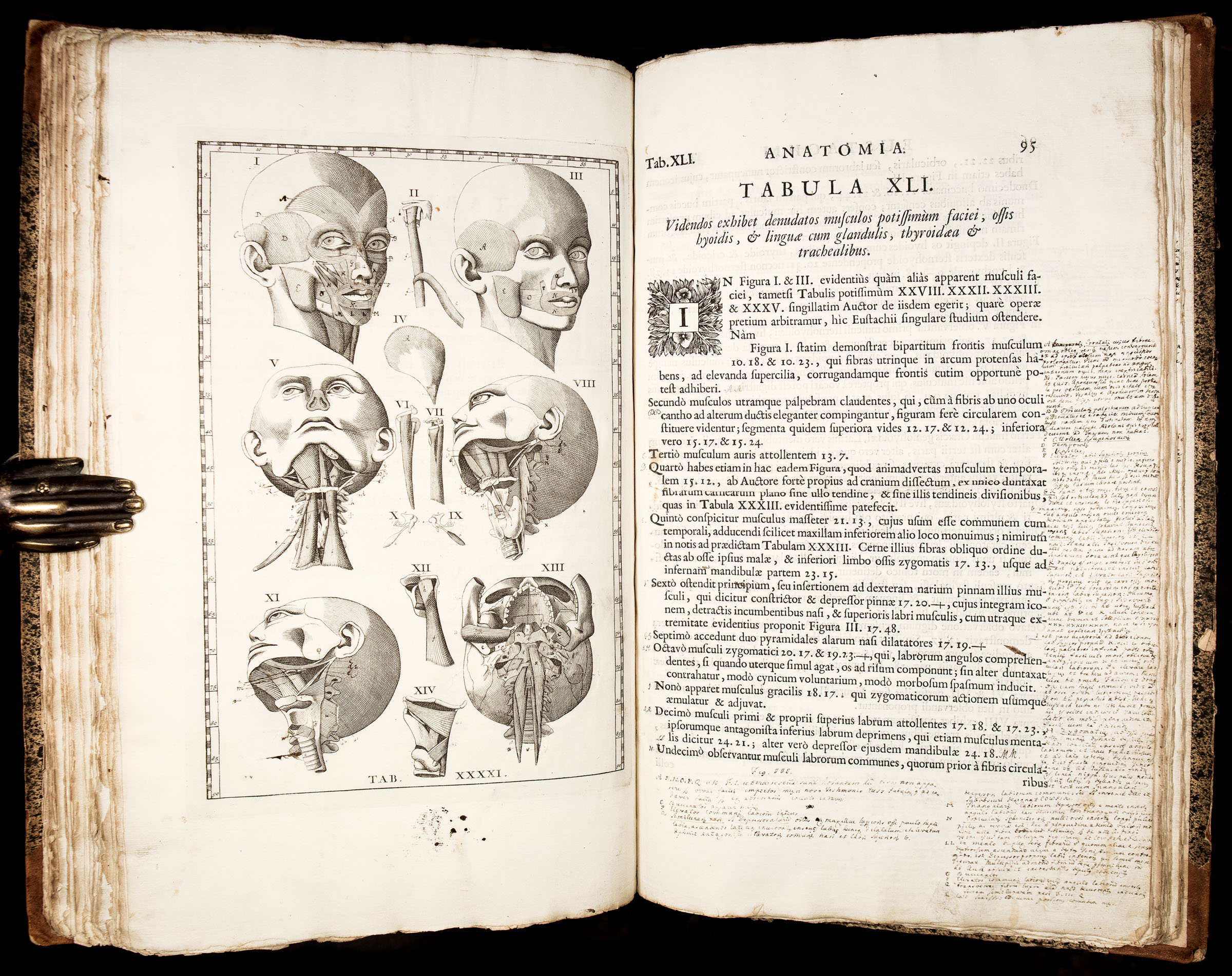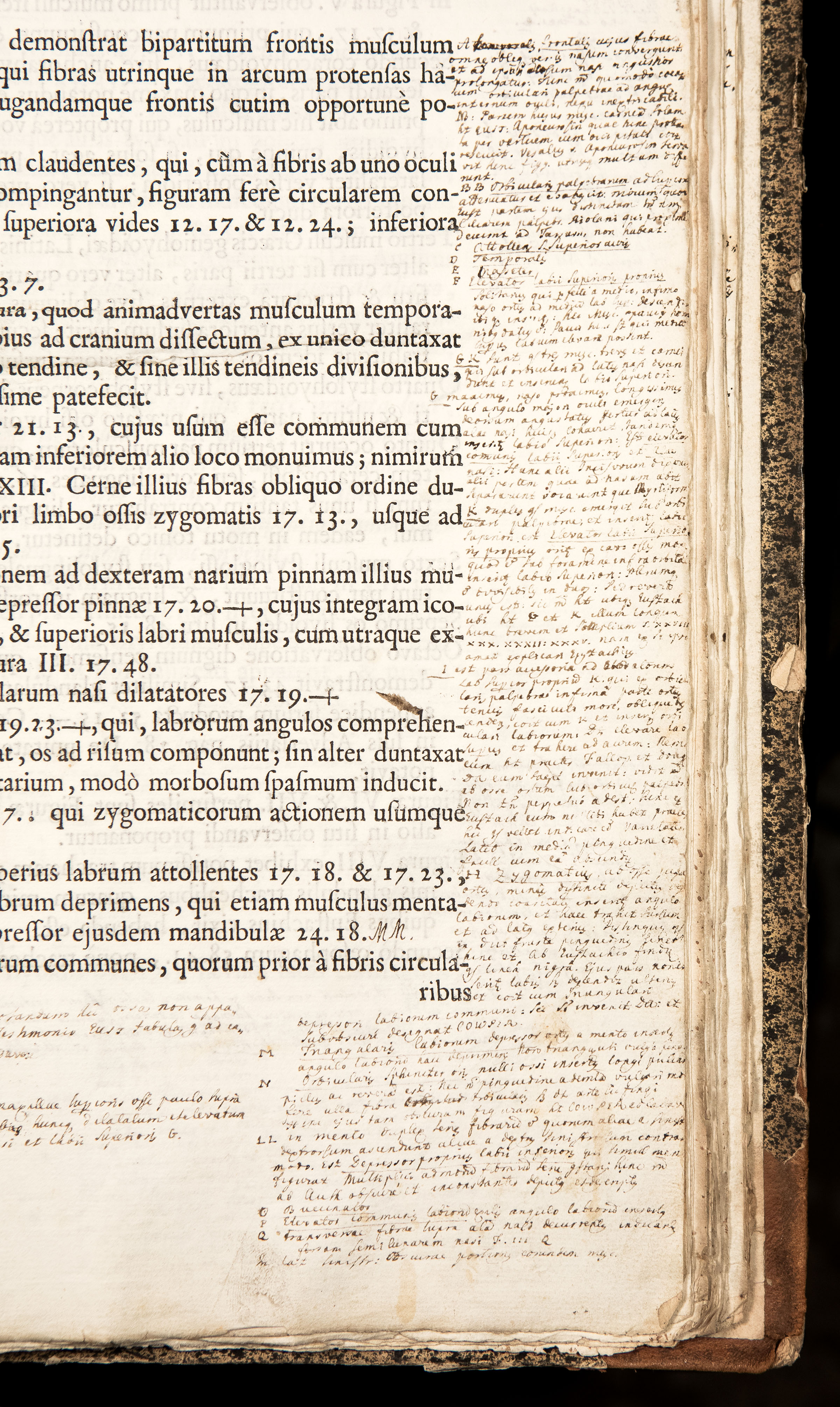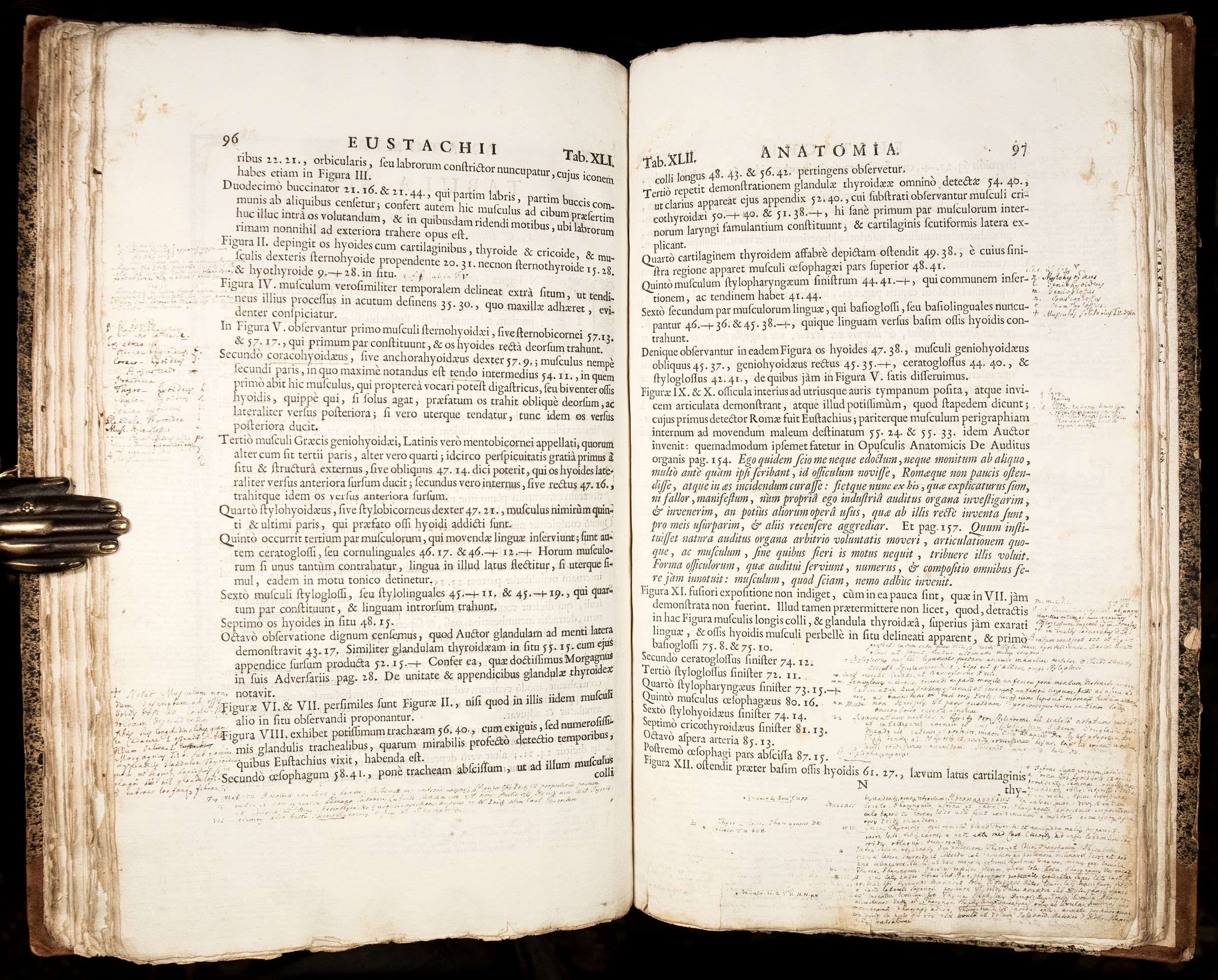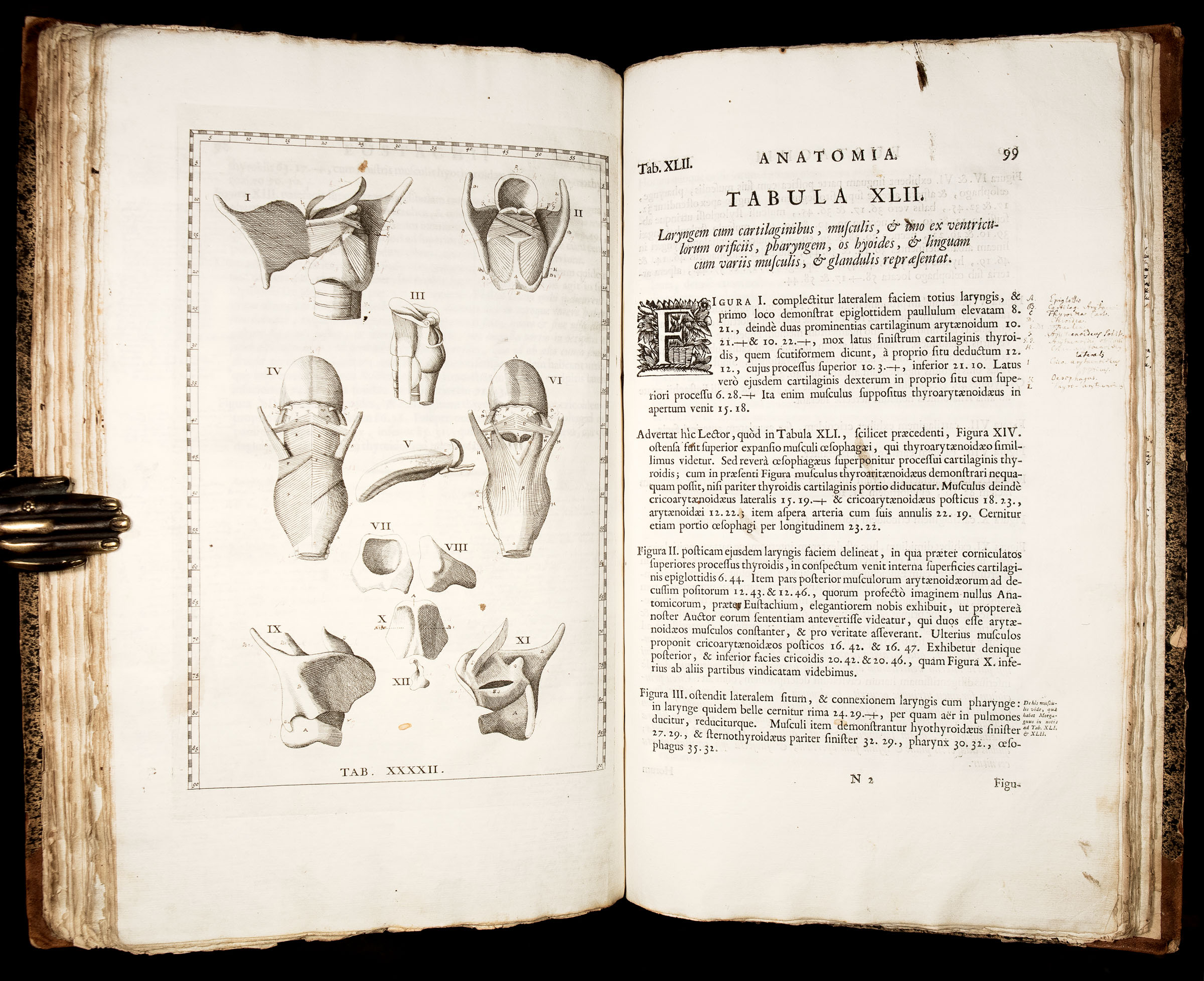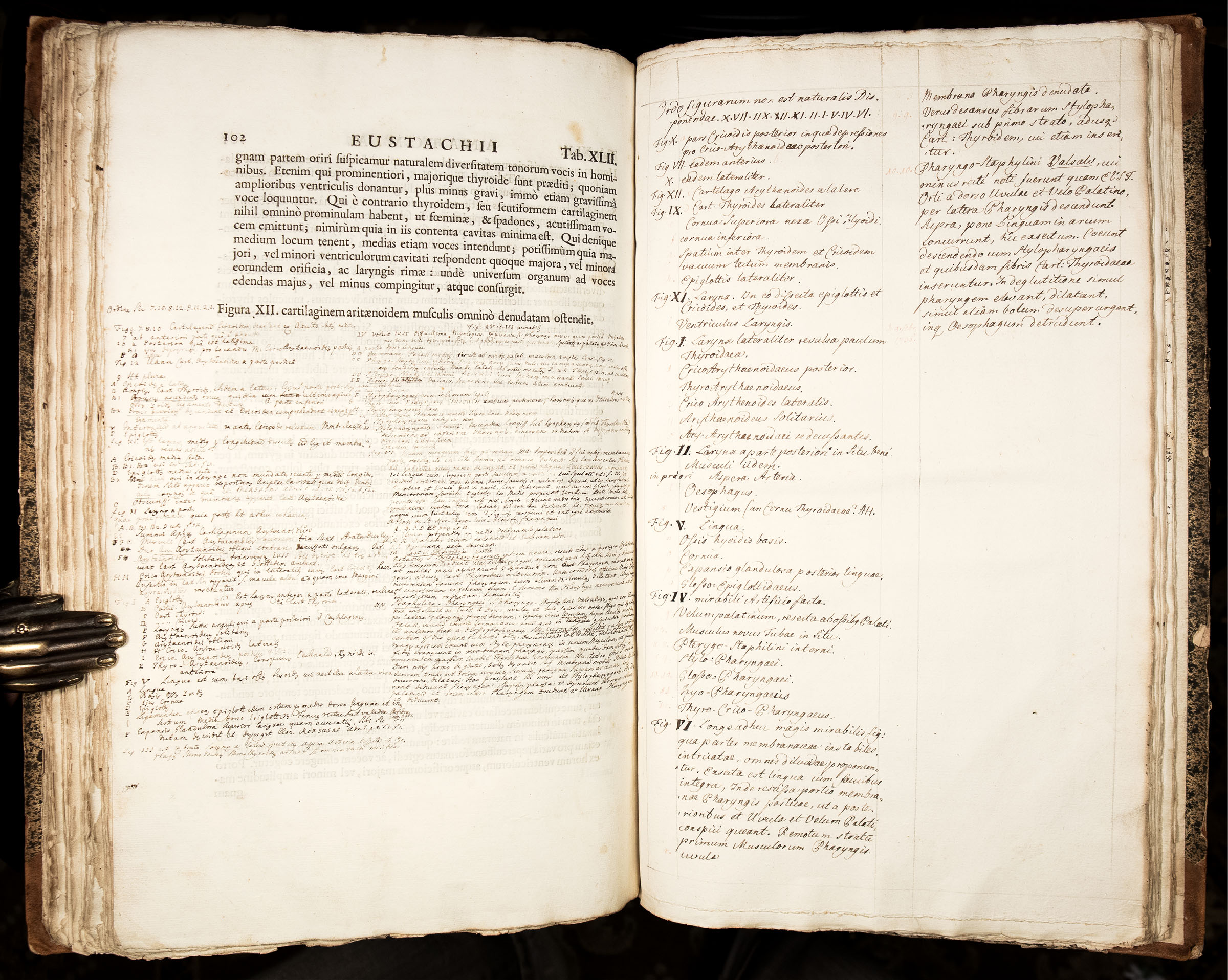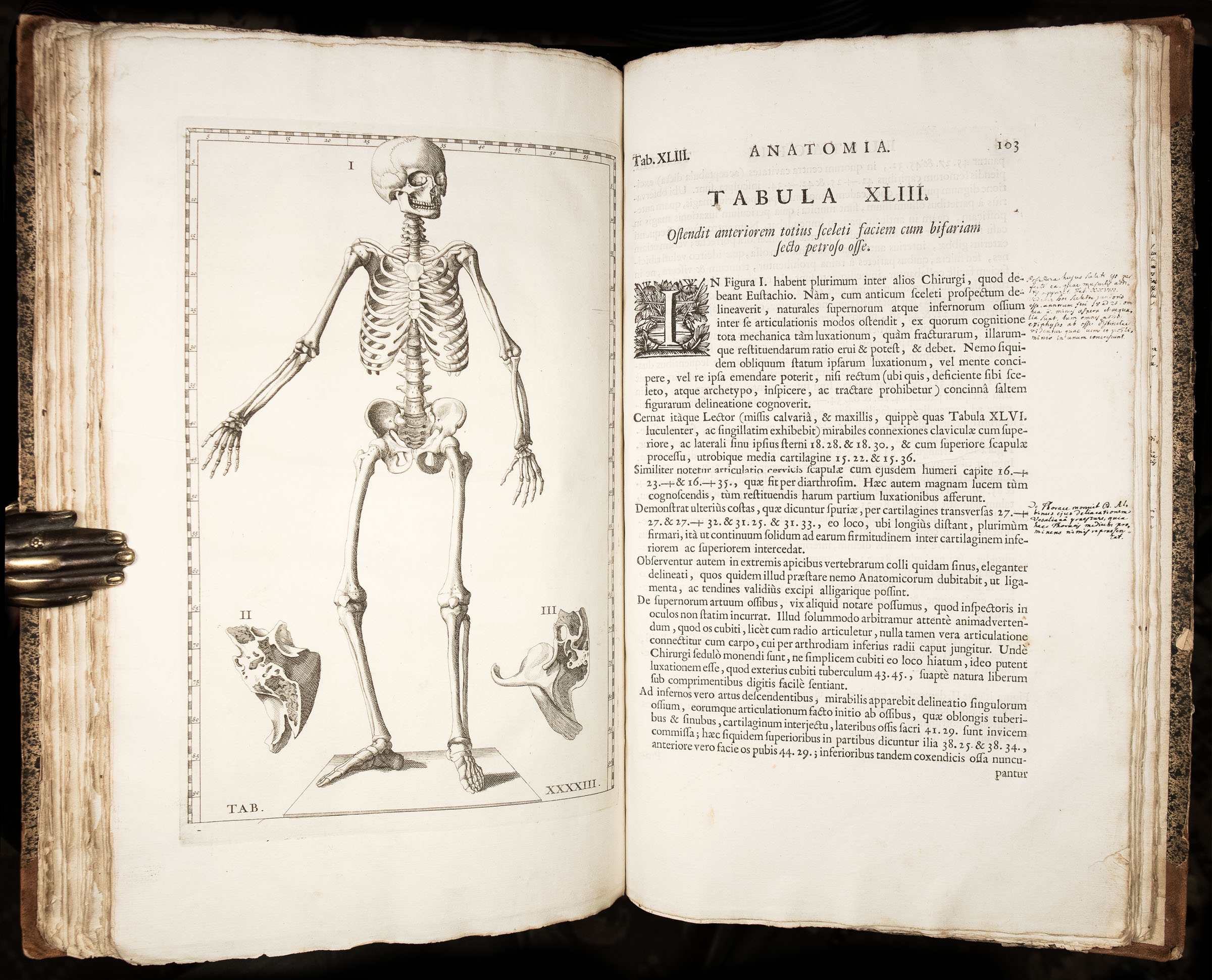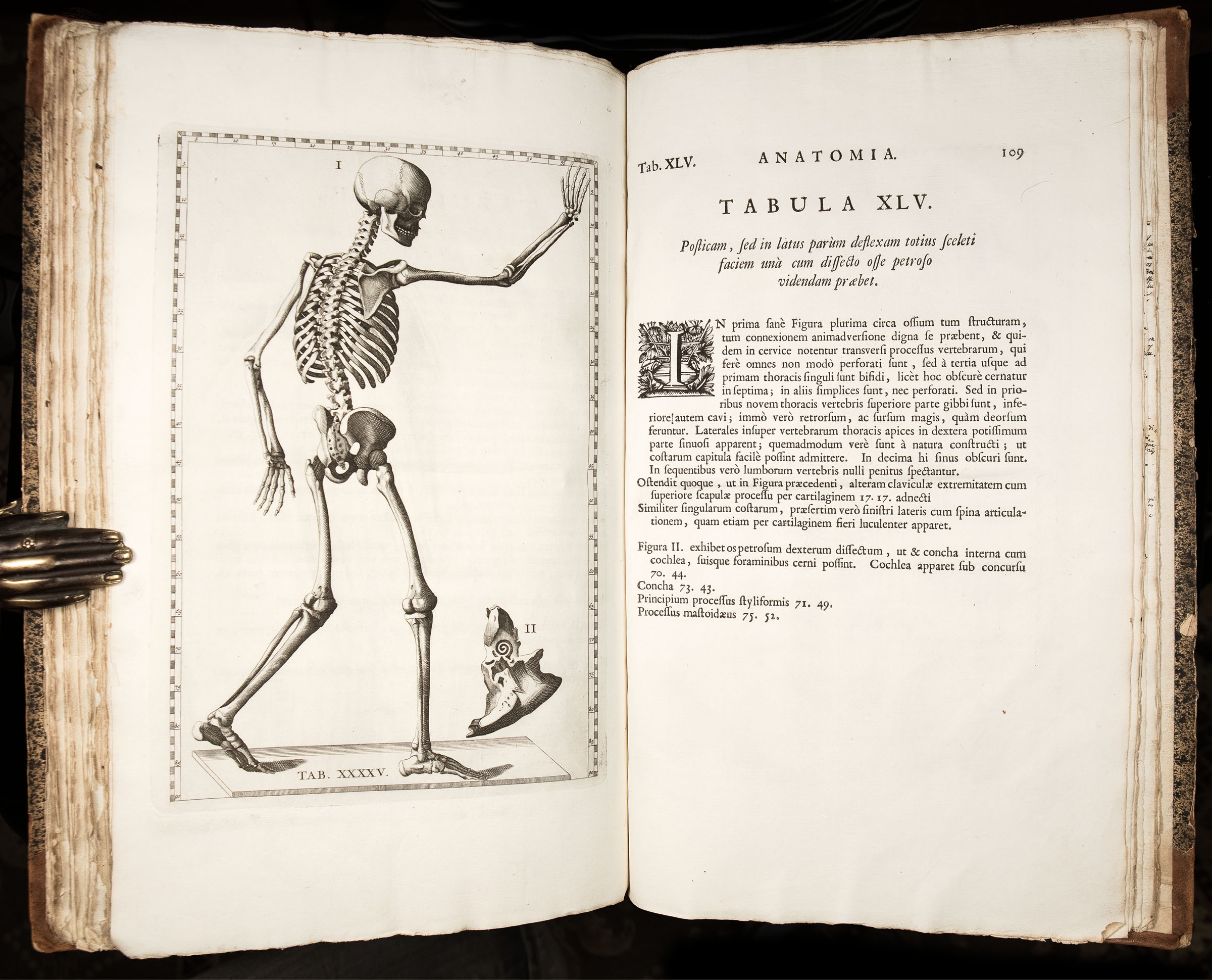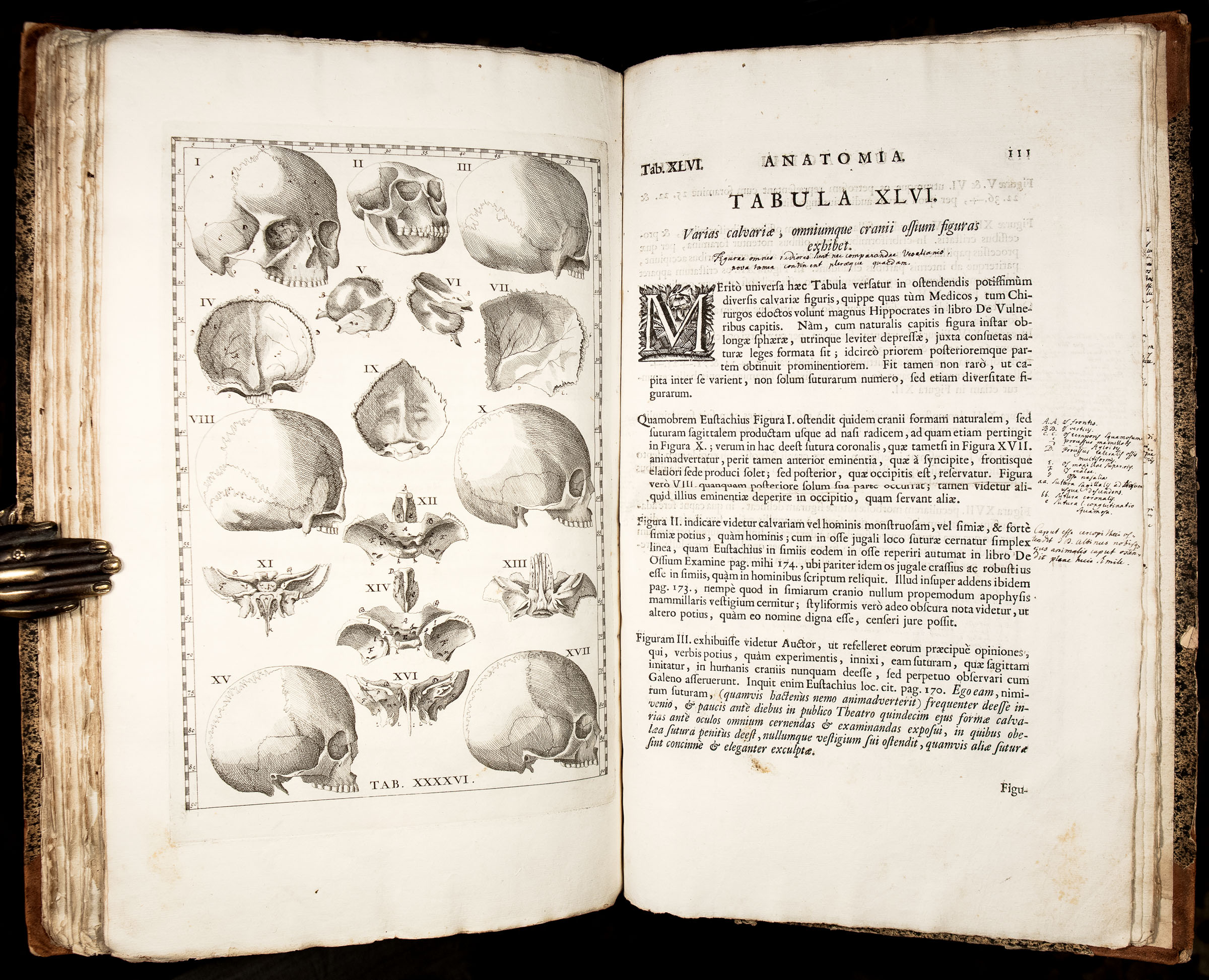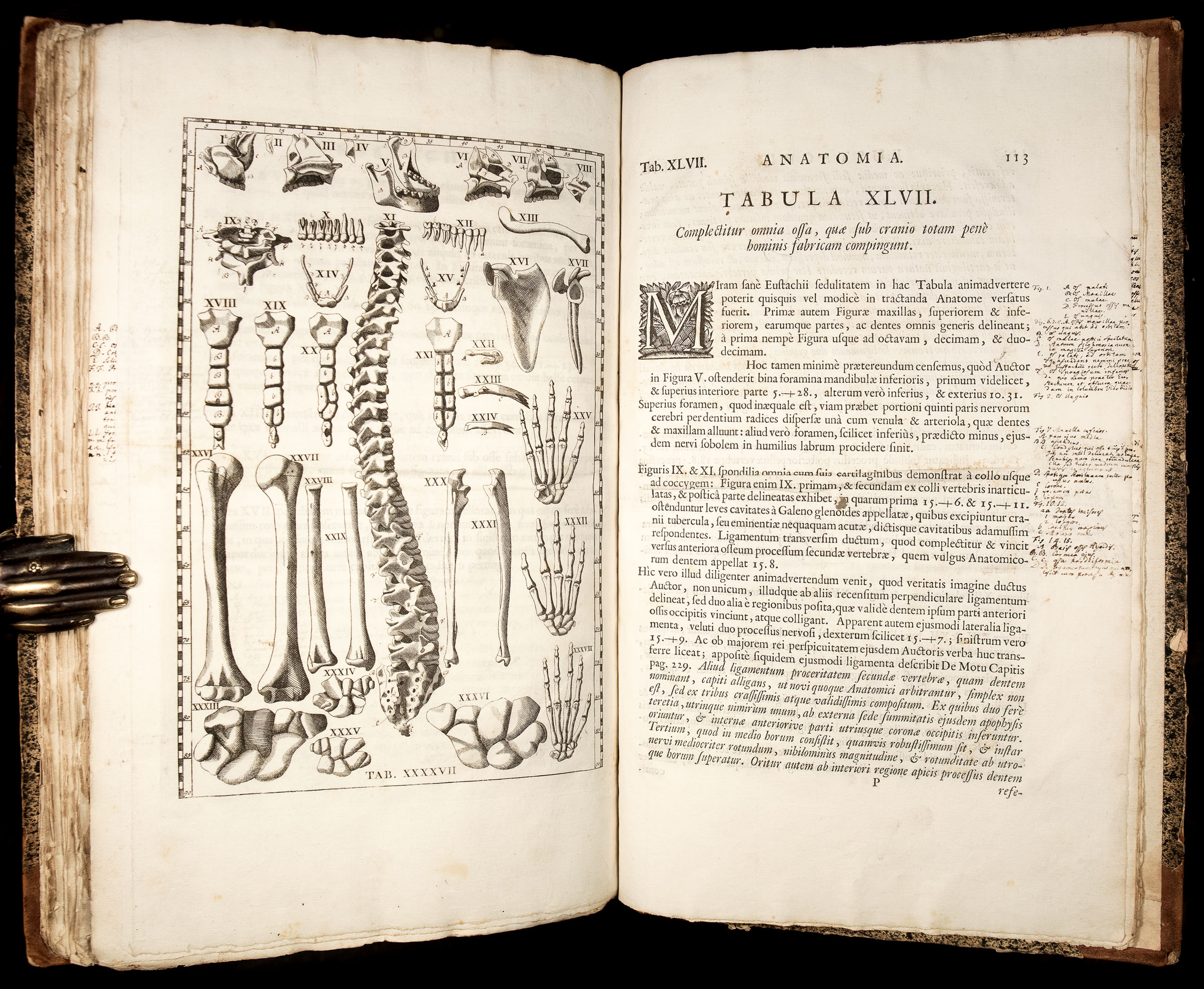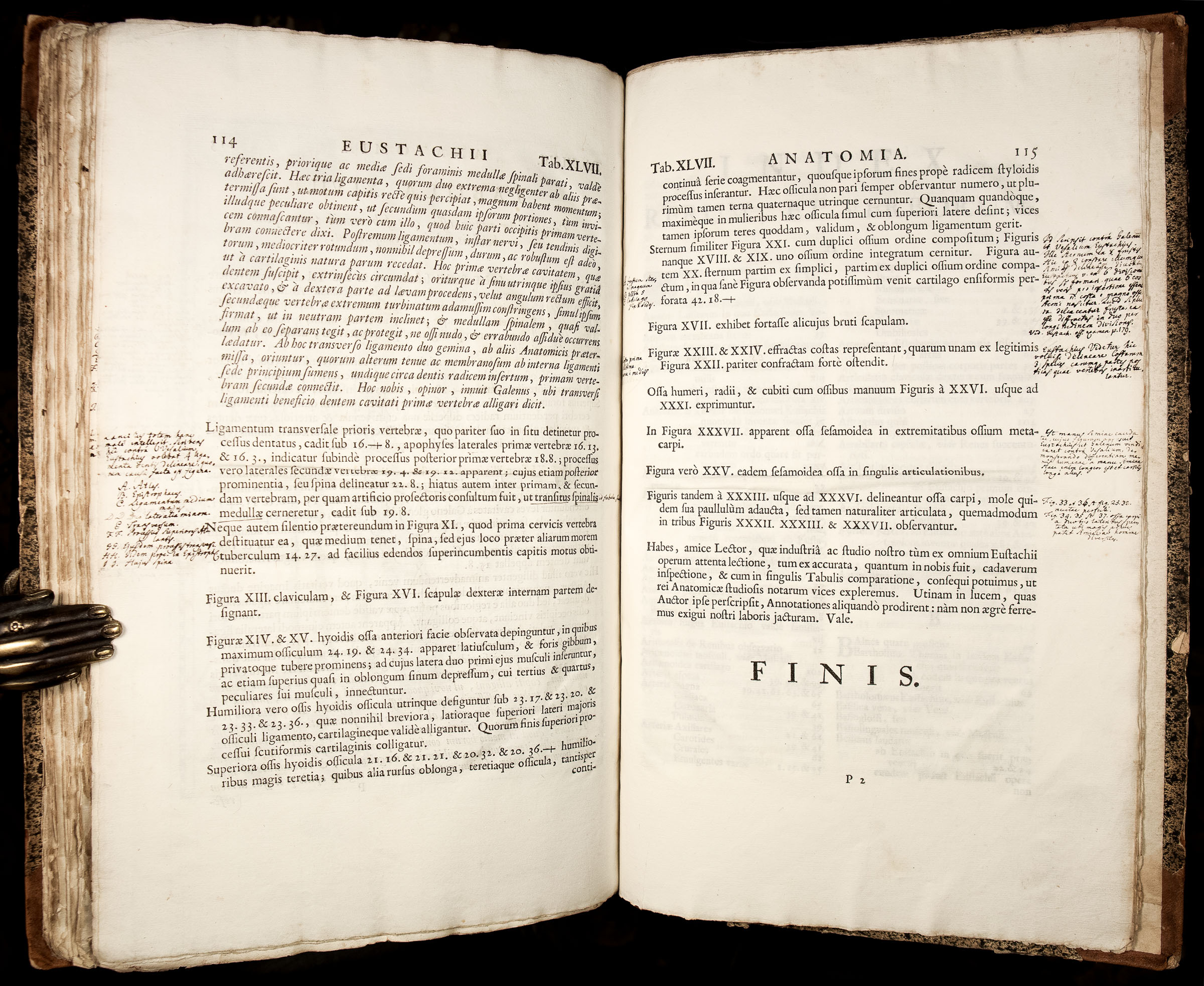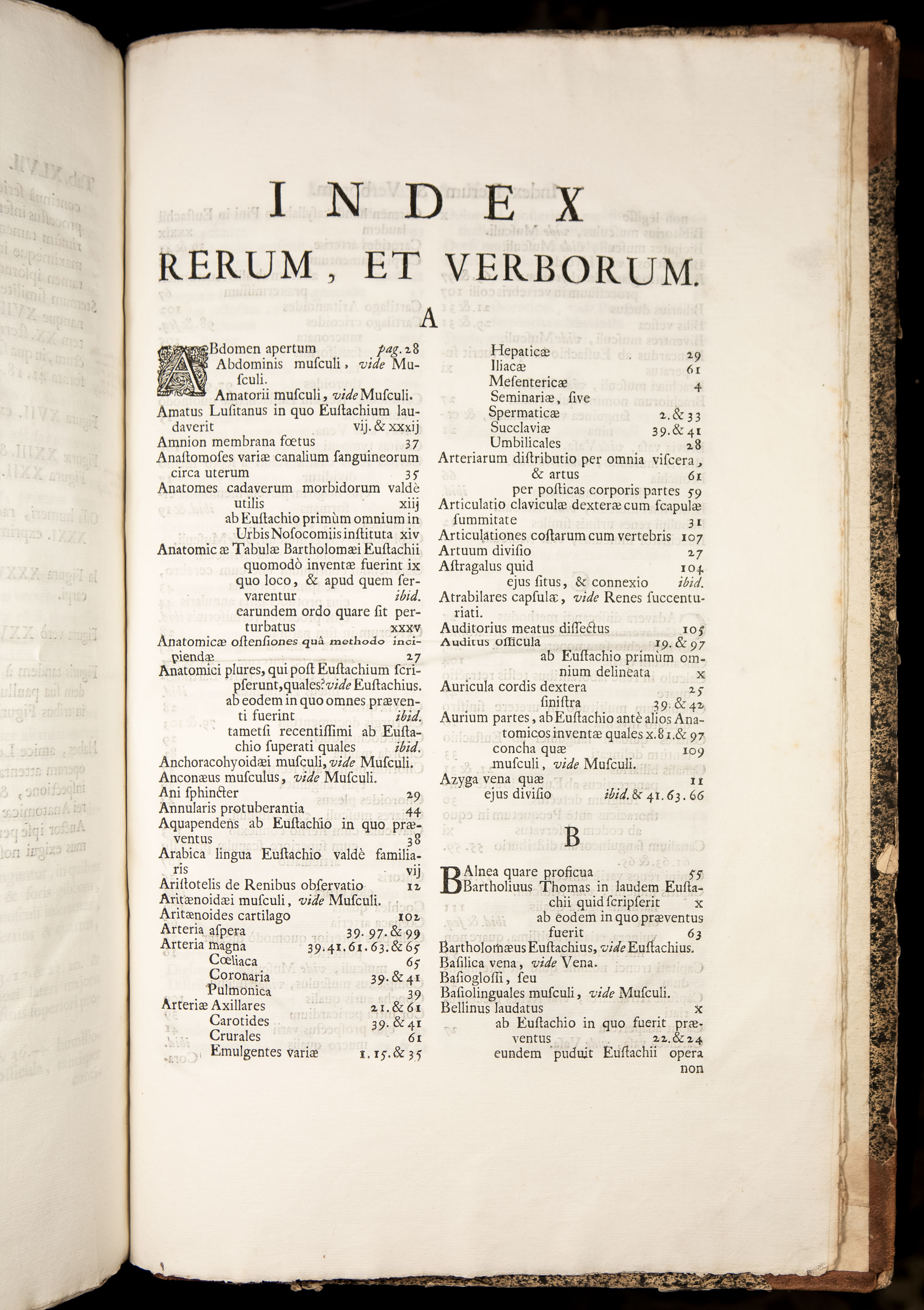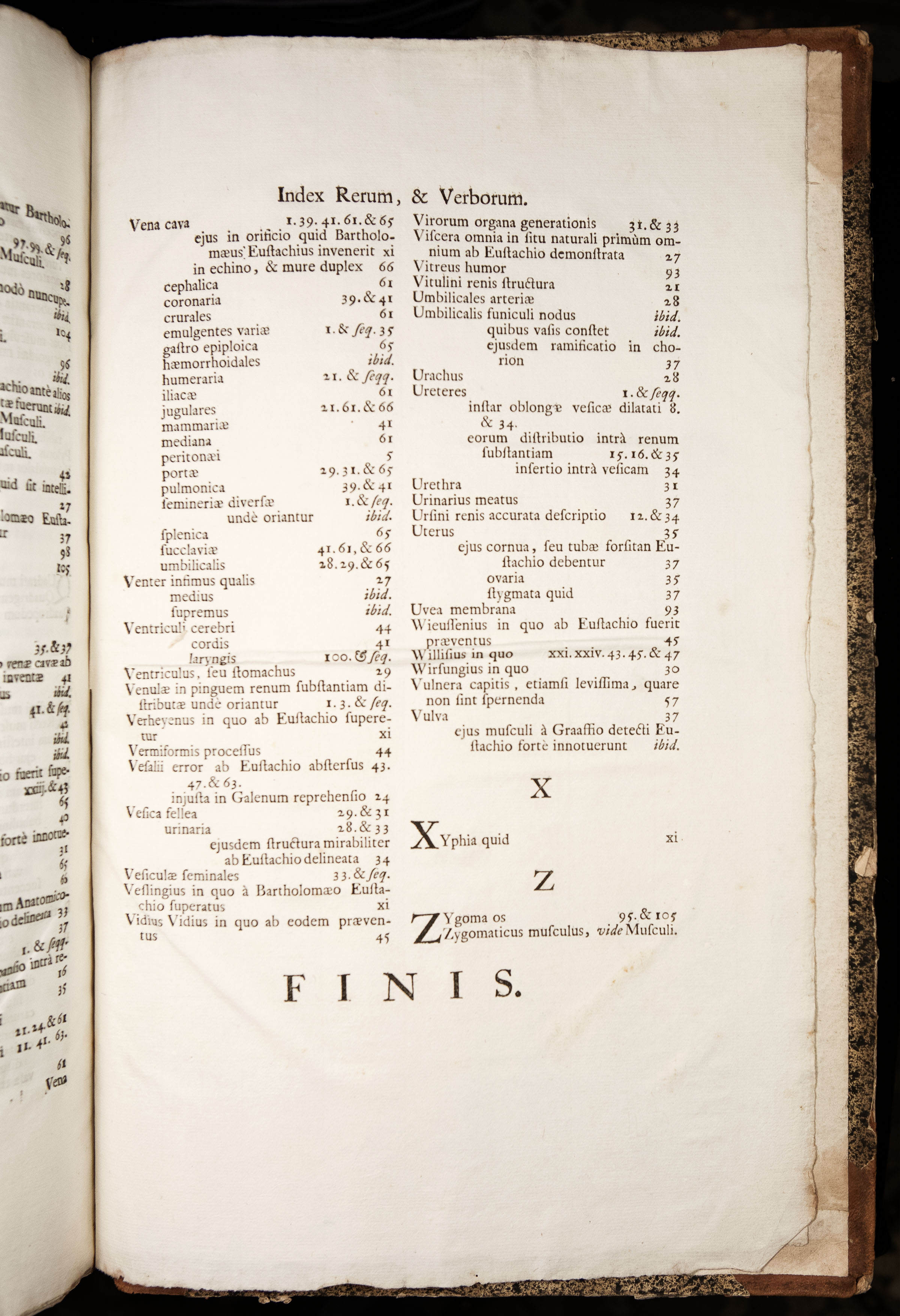
$9,000 (SOLD)
Amsterdam, printed by R. and G. Wetstein, 1722.
2ND EDITION. Text in Latin, edited by Giovanni Maria Lancisi. Illustrated with 47 fine copperplate engraved anatomical plates. A UNIQUE COPY WITH EXTENSIVE MANUSCRIPT NOTES BY ALBRECHT VON HALLER (1708 – 1777), THE FATHER OF MODERN PHYSIOLOGY.
“Bartholomeo Eustachi, usually latinized as Eustachius, was an important anatomist in the 16th century, arguably second only to his contemporary and rival Andreas Vesalius. He was the first to identify several important anatomical structures, including the suprarenal glands, though he was probably not the first to describe the Eustachian tube. However, it has been hard to evaluate his achievements, because during his lifetime he published only some short monographs, and his career as a teacher in Rome is not well documented. He and his assistant P.M. Pini were the first to use copper plate engravings to illustrate human and animal anatomy, but most of their engravings were not published in their time, and the original plates were lost for some 140 years after the death of Eustachius. Early in the 18th century, these plates were rediscovered by the anatomist and papal physician G.M. Lancisi; he published the engravings in a book which aroused much interest and many reprintings. In 1744, Bernhard Siegfried Albinus of Leiden University published a version of these engravings, with commentaries by himself.
The engraved illustrations prepared by Eustachius and Pini are clear and largely accurate. They idealize the findings of actual dissections, and have a diagrammatic quality that facilitates understanding and memory. They are the ancestors of later anatomical atlases, which have helped generations of surgeons in teaching and in planning operations.” (Donald Simpson, The papal anatomist: Eustachius in renaissance Rome, ANZ Journal of Surgery, 2011 Dec; vol. 81, p.905)
"Had Eustachi's full series of forty-seven anatomical coverplates been published at the time of their completion in 1552, Eustachi would have ranked with Vesalius as a founder of modern anatomy [...]. The plates are strikingly modern, produced without the conventional sixteenth-century decorative accompaniments [...]. The images are generic figures, composites of many anatomical observations, and are mathematically as well as representationally exact." (Norman).
"A romantic history attaches to this fine collection of plates, drawn by Eustachius himself and completed in 1552. They remained unprinted and forgotten in the Vatican Library until discovered in the early 18th century and were then presented by Pope Clement XI to his physician, Giovanni Maria Lancisi. The latter published them in 1714 together with his own notes. These copperplates are more accurate than the work of Vesalius. Singer was of the opinion that had they appeared in 1552 Eustachius would have ranked with Vesalius as one of the founders of modern anatomy. He discovered the Eustachian tube, the thoracic duct, the adrenals and the abducens nerve, and gave the first accurate description of the uterus. He also described the cochlea, the muscles of the throat and the origin of the optic nerves." (Garrison-Morton 391)
This remarkable copy contains numerous and extensive scholarly manuscript notes in Latin (both in the margins of the printed text leaves of the book and on ten additional leaves of contemporary paper stock bound in at appropriate places) by Swiss biologist and ‘the father of experimental physiology’, ALBRECHT VON HALLER (1708 – 1777) who made prolific contributions to physiology, anatomy, botany, embryology, poetry, and scientific bibliography. At the University of Göttingen, where he served as professor of medicine, anatomy, surgery, and botany, Haller undertook the exhaustive biological experimentation that was to make his encyclopaedic Elementa Physiologiae Corporis Humani (“Physiological Elements of the Human Body,” 8 vols., 1757–66) a landmark in medical history. Haller was the first to recognize the mechanism of respiration and the autonomous function of the heart; he discovered that bile helps to digest fats, and he wrote original descriptions of embryonic development. He also summarized anatomical studies of the genital organs, the brain, and the cardiovascular system. Most important were his contributions to the understanding of nerve and muscle activity.
Haller’s note on the front endpaper states that he compiled the notes from Albinus (whose lectures he attended at Leyden in 1725-7) and from his personal observations. The ‘ex Albinus’ part of Haller’s notes (which appears to occupy the inserted extra leaves) is of additional interest as they may shed light on the preparation of Bernard Albinus’ celebrated edition of Eustachius Explicatio tabularum anatomicarum Bartholomaei Eustachii, published in Leyden in 1744 (the notes here were made not later than 1735, when Haller sold the book to his pupil and friend, J. J. Ritter).
The inscriptions on the front endpaper of our copy (see the Provenance section below) suggest a fascinating chain of provenance involving (at least) three ‘generations’ of distinguished Swiss physicians apparently passing the book from a teacher to a student: Johann Rudolf III Zwinger (1692 - 1777), one of Von Haller’s teachers, Albrecht Von Haller himself, and then his student and colleague Johann Jacob Ritter (1714-1784), who received or bought the book from Haller in 1735, and in 1759 presented it to the German National Academy of Sciences - Leopoldina.
Bibliographic references:
Blake p. 139; Choulant/Frank p. 202; Wellcome II, 536.
Physical description:
FOLIO, leaves measure approx. 39 x 24 cm; apparently untrimmed retaining all témoin edges. Bound in contemporary sheep-backed speckled boards (gilt-stamped oval supralibros to front cover).
Pagination: XLIV, 115, [13], and 47 leaves of plates; plus ten additional paper leaves bound in containing manuscript notes (to Plates IX-XVII & CLII).
Complete, including half-title. Title-page printed in red and black, with a large engraved vignette after Pier Leone Ghezzi, depicting a dissection of a cadaver in an anatomy theatre, 47 engraved anatomical plates by Giulio de' Musi after drawings by Eustachi and Pier Matteo Pini; woodcut ornamental initials. One plate with neat contemporary hand-coloring.
Preliminaries include a dedication by the publishers to Boerhaave and Albinus, followed by Lancisi’s preface and other prefatory material by Francesco Soldati and others, and a table of contents.
Provenance:
The copious scholarly notes in contemporary hand on many text leaves and on ten additional leaves bound in, are apparently written by Albrecht von Haller. A contemporary inscription (to front free endpaper): “Alb. Haller notas concinnavit ex Albinus et propriis observatis” (i.e. Alb[ertus] Haller prepared these notes from Albinus and from his own observations”). This inscription indicates that the notes are by Albrecht von Haller (1708-1777), a distinguished Swiss anatomist, physiologist, naturalist, encyclopedist, bibliographer and poet, often referred to as "the father of modern physiology."
Another inscription (just under the one described above) is an acquisition note: “Jure emptionis nunc ab ipso celeberrimo Hallero me possidet, Jac[obus] Ritter. / 4 Novemb. 1735”, indicating that the book was purchased from Von Haller by his pupil and friend, Johann Jacob Ritter (1714-1784), a Swiss physician and surgeon, student of Albrecht von Haller in Bern, and (1733-37) of Johann I Bernoulli in Basel, practical physician and lecturer in Bern, Homburg and Lauterbach.
Below these notes there is another inscription announcing that Albinus has edited a new edition [Leyden, 1744] of this book, with detailed explanations: “Albinus novam hujus libri editionem cum explicationibus accuratis curavit; referate mihi, Dr. Zwingero,” almost certainly by Johann Rudolf III Zwinger (1692 - 1777), Swiss anatomist, and one of Von Haller’s teachers.
On verso of the same endpaper is a presentation inscription, dated 1759, from Ritter to the German National Academy of Sciences - Leopoldina (founded 1652), here referred to by its original Latin name ‘Academia Imperialis Naturae Curiosorum.’ Leopoldina’s handsome gilt supralibros also appear on the front cover, and its oval stamp on the outer margin of the title-page.
An armorial red wax seal, almost certainly of Von Haller, to bottom fore-corner of the half-title.
Condition:
Very Good antiquarian condition. Complete, with all plates present. Binding rubbed, with wear to extremities, corners bumped; spine worn with some minor cracks and chipping causing some loss of leather at head and foot of spine (but joints and hinges intact, boards firmly attached). Half-title with a minor marginal tear at top of gutter, and with a red wax-seal to bottom outer corner; title with an old oval stamp of Leopoldina. Numerous pages with extensive contemporary manuscript marginalia (see Probenance above). Occasional light soiling, a few small stains, ink-spots or smudges. Couple of discreet old marginal repairs. In all a very pleasing, bright copy with vast margins (edges completely untrimmed), and with stellar provenance and fascinating annotations.
